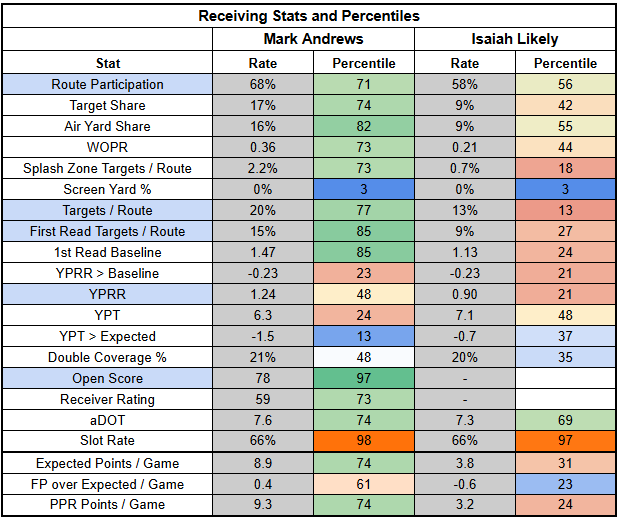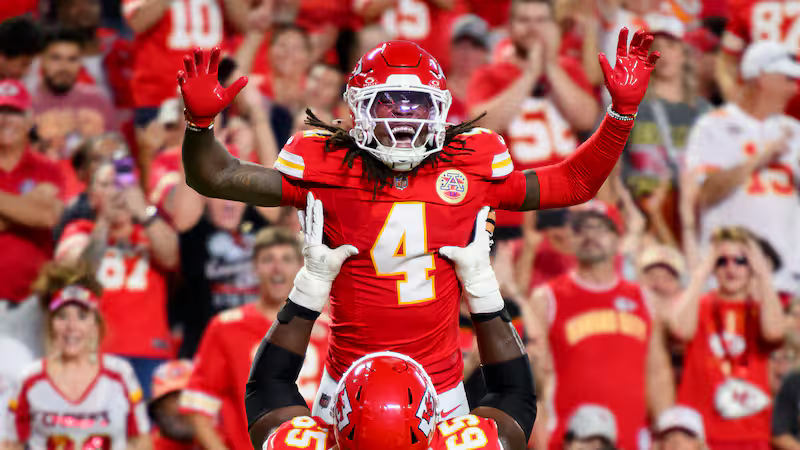
Thanksgiving Walkthrough: Wild Rice
Welcome to the Thanksgiving Walkthrough.
In this article, I'll outline critical fantasy football context for a glorious Thanksgiving slate of football.
(The stats below are from PFF, NFLfastR, rbsdm.com, RotoViz, FantasyLabs, Fantasy Life, Fantasy Points, ESPN, FTN, and NFL Next Gen).
PROE data is available for subscribers at the bottom of the post.
Due to the Thanksgiving schedule, the Week 13 Walkthrough will publish Saturday morning instead of Friday morning.
Quick Links
- Packers at Lions, 1 PM
- Chiefs at Cowboys, 4:30 PM
- Bengals at Ravens, 8:20 PM
Packers at Lions, 1 PM
Packers
Implied Team Total: 23
The Packers, from a high level, are one of the most predictable teams in football. They are going to run the ball. Fittingly, with their starting running back out last week, they ran the ball more than they had all season, posting just a 39% pass rate.
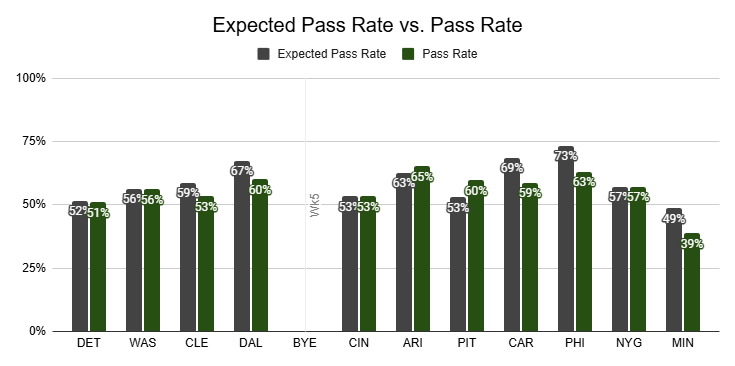
The Packers, as they increasingly have been, were also very conservative on 1st-and-10.

Last week's game plan was influenced by going against a Vikings passing game that was not an NFL-caliber operation with JJ McCarthy under center.
It's also related to Jordan Love's separated (non-throwing) shoulder. Matt LaFleur is unlikely to open things up with Love at less than full health.
But Love injured his shoulder in Week 11. This conservative approach predates his injury; this is also related to the Packers' offensive identity.
This offensive approach doesn't just rely on the run; it's slow; the Packers are tied with the Falcons and Ravens for the slowest situation-neutral pace in the NFL.

The Packers now get a Lions defense that some opponents have been pass-heavy against, but playing Detroit doesn't really require a pass-first approach. In fact, the Giants were just run-heavy against them in an overtime loss, and the Eagles were very run-heavy in a win.

Even while playing through an injury, Jordan Love has been very efficient over the last two weeks.

And Love has been extremely efficient this season as a whole, ranking QB3 in EPA per game and QB9 in success rate.

So, the potential lack of pass volume isn't because the Packers are trying to hide a struggling passing game. Instead, it's likely a belief that the passing game functions best when working off the run game—especially with Love at less than full health.
With that in mind, we can expect the Packers to run the ball against the Lions, despite Detroit's strong run defense.

The Packers will have Josh Jacobs back for this game. Jacobs was limited all week in practice but doesn't carry a final injury designation. He will play.
Jacobs will likely cede some work to Emanuel Wilson, potentially in line with Weeks 7-8, when he was also playing through injury.

Jacobs hasn't been a very efficient runner this year, is unlikely to have his full snap share, and gets a tough matchup. However, because the Packers are likely to lean on the run he's a good bet for decent carry volume and is a high-end RB2.

Emanuel Wilson filled in admirably for Jacobs last week, posting 26.5 PPR points, scoring two TDs, and posting 30 RYOE with a 46% success rate. But Wilson's production was also a product of volume. He rushed 28 times and recorded 30 touches. That volume was supported by a ton of positive game script for the Packers. Wilson didn't even have to dominate carries to touch the ball 30 times.
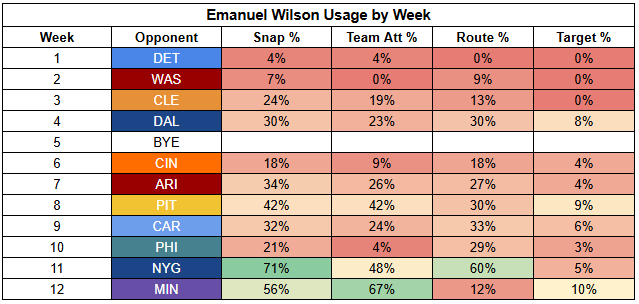
For Wilson, last week was a bit of a perfect storm in terms of opponent. He faced a run-funnel defense with a disastrous QB on the other side. It's helpful to know that he can carry the load if Jacobs is out in the future. But with Jacobs back, he's just a hail-mary bet on a TD.
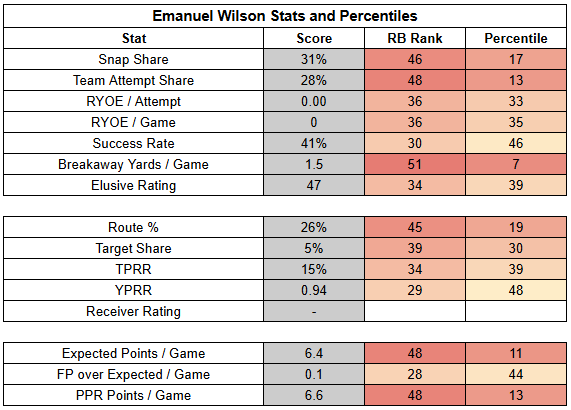
In the passing game, the Packers will face a Lions defense that has shown a real weakness for allowing big plays, which Jameis Winston highlighted in the most fun way possible.
JAMEIS WINSTON RECEIVING TD FROM GUNNER OLSZEWSKI.
— NFL (@NFL) November 23, 2025
NYGvsDET on FOX/FOX Onehttps://t.co/HkKw7uXVnt pic.twitter.com/A5D17S03R3
The Lions aren't a bad pass defense overall. But, especially if the Packers can get the run game going, Green Bay should be able to take shots downfield effectively. The Lions rank sixth-worst in preventing explosive plays.
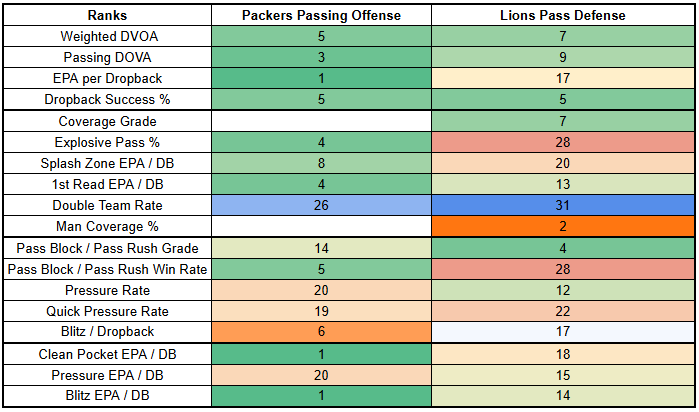
The Packers are also a very effective play action team, and teams are utilizing play action against the Lions at a high rate. The ability to deploy play action against this defense will likely reinforce the Packers' typical mode of operation here.

With pass volume potentially limited this week, Romeo Doubs' declining route participation isn't a great sign.
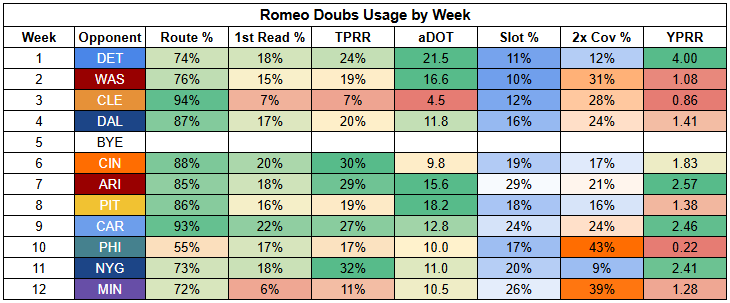
More and more, Christian Watson looks to be the No. 1 in the offense. Watson's big-play skillset also looks like a better fit for this matchup.
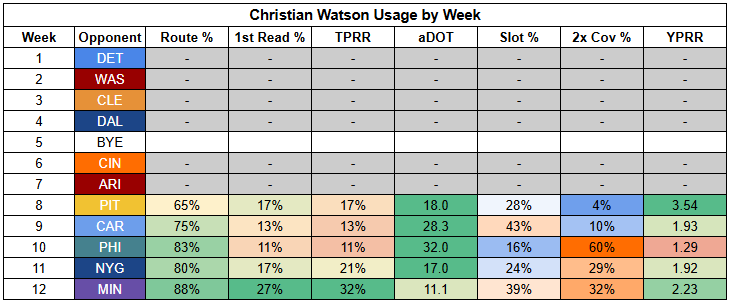
If the Lions push the Packers into a pass-heavy script, we could see a strong game from Doubs as a consistent target earner. But as part of a more curated passing attack, Watson looks like the more interesting play—Watson profiles as a WR3 with Doubs as a WR4.
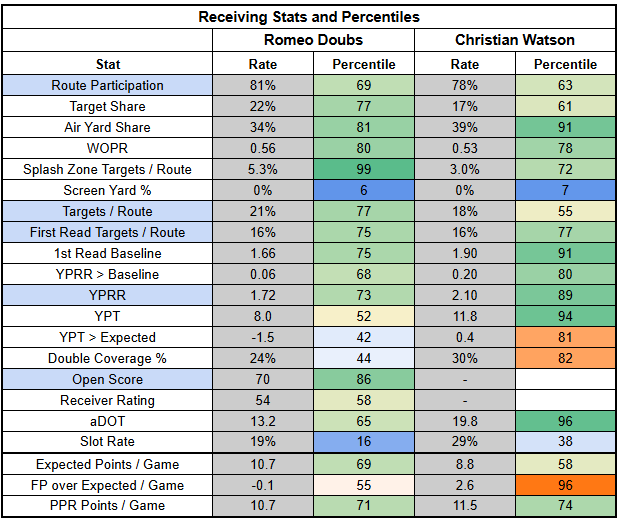
With Matthew Golden out last week, Dontayvion Wicks was in a near full-time role.
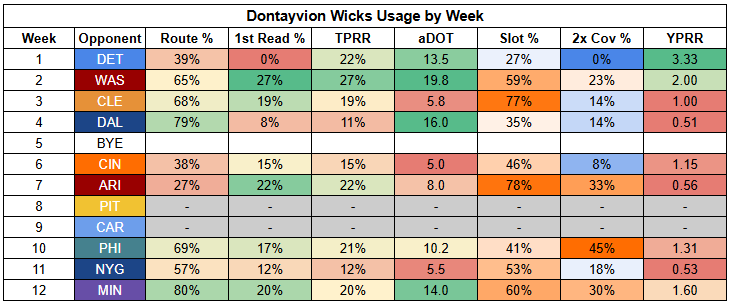
Golden is questionable and could return this week. He'd likely push Wicks back into a part-time role. For his part, Golden is unlikely to matter.
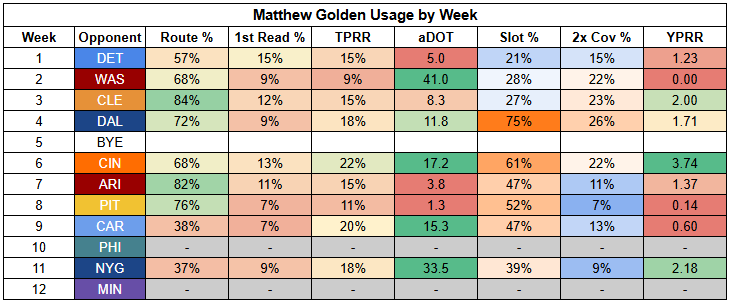
Wicks has not been efficient this year, so as a part-time WR, he's just a dart throw.

At tight end, the Packers are continuing to deploy a three-way split. If I had to roll out any of these guys, it would be John Fitzpatrick. But I would prefer to avoid doing that.
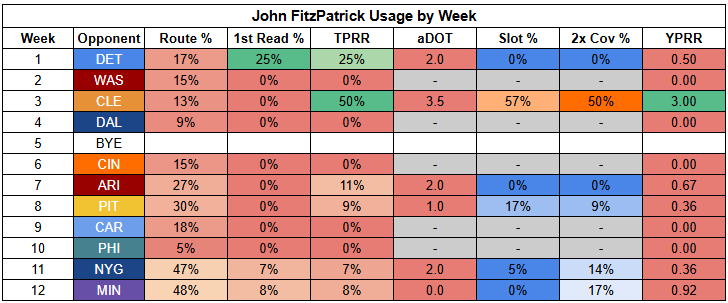
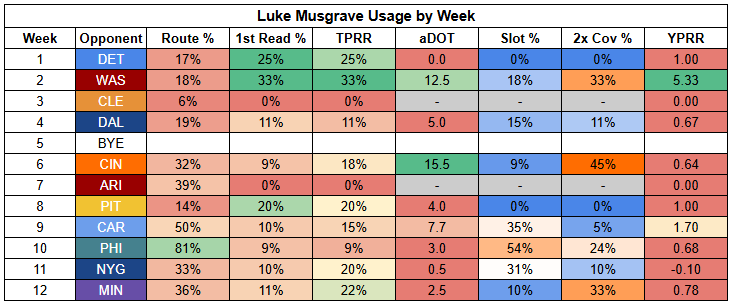
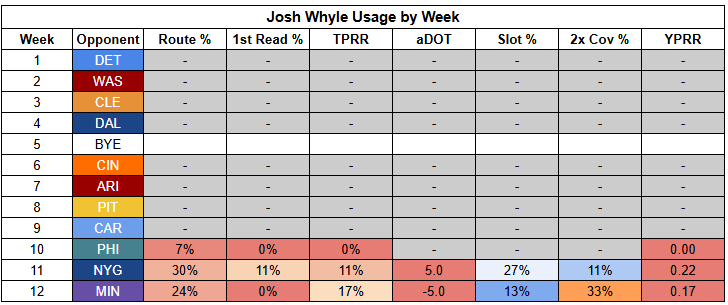
Lions
Implied Team Total: 25.5
The Lions are coming off an overtime win over the Giants, in which they scored 34 points. Unfortunately, Jared Goff was less of a reason that the Lions won and more of a reason that they had to go to overtime in the first place.
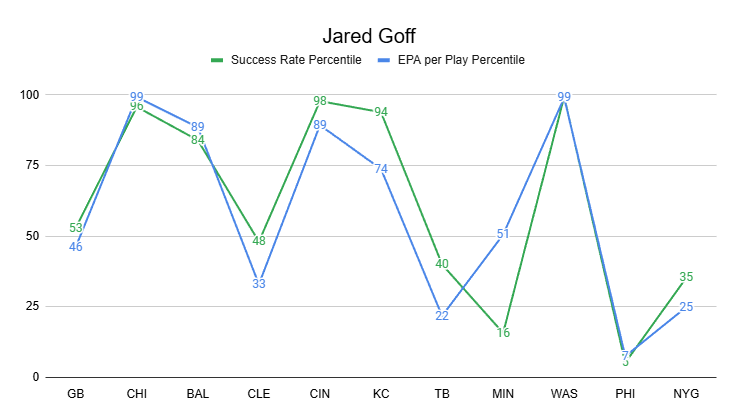
Even after a couple of down weeks, Goff still ranks a respectable QB14 in EPA per game and QB11 in success rate.
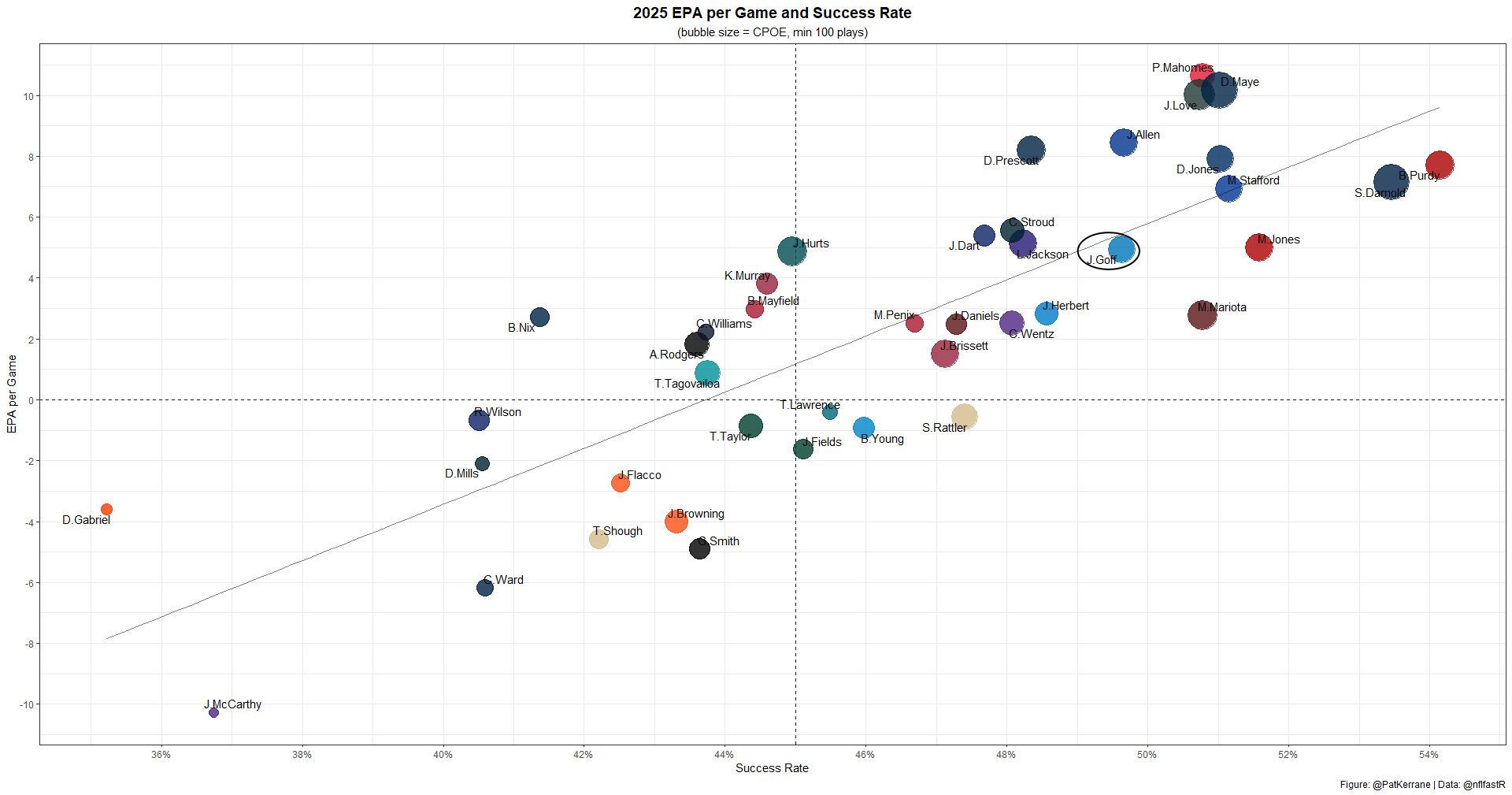
But there are some concerning elements to Goff's profile. For one, he's been very conservative this year, even by his standards. His 6.7 DOT is the lowest of his entire career, as is his 7% deep pass rate. Goff has a career aDOT of 7.6 and a deep pass rate of 9%, so this year he's not dramatically lower than usual. But with Ben Johnson no longer running the offense, he does look to be a bit aggressive.

Goff has also been very poor under pressure this year, with the Lions turning in the fifth-worst efficiency on pressured dropbacks.
This problem is compounded by the Lions' offensive line, which isn't blocking nearly as well as usual.
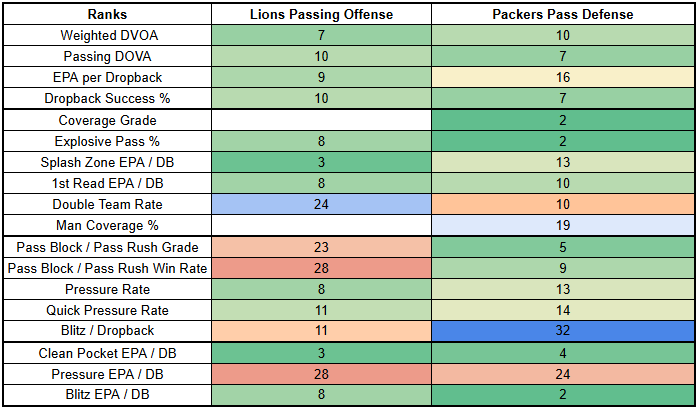
The Lions' tackles have been playing through injuries. As is now customary, Taylor Decker has been limited in practice this week with a shoulder injury; Penei Sewell has been limited with an ankle injury. Both are expected to play, but are clearly at less than 100%. Critically, starting center Graham Glasgow is officially out with a knee injury, further weakening an offensive line that will be challenged this week.
Expectations were so high for Micah Parsons in Green Bay that it feels like he's had a down year, but he really hasn't. Parsons ranks EDGE3 in pass rush win rate behind Nick Herbig and Will Anderson and EDGE2 in pass rush grade behind Myles Garrett. He remains a force.
One way to mitigate the Packers' pass rush is to get the ball out quickly.
That game plan will rely on Amon-Ra St. Brown, who overcame a bad game from Goff to post a 9/149/1 receiving line against the Giants.
He has been the engine of the Lions' passing game all year.
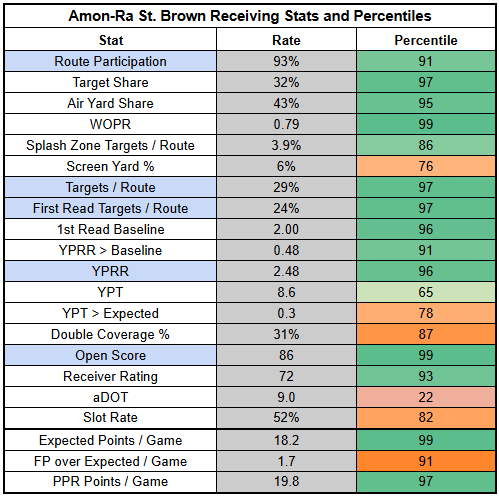
However, when the Lions played the Packers in Week 1, Green Bay went out of their way to take away St. Brown. We saw the Eagles deploy the same tactic in Week 11, again, successfully. We can expect plenty of double coverage for St. Brown here.

Taking away St. Brown isn't just about limiting the Lions' top playmaker; it's about making Goff hold the ball.
Goff has a 2.58-second time to throw. Only Tua Tagovailoa (2.46) is faster. And on first-read dropbacks, Goff ranks QB8 in EPA per dropback. However, on non-first-read dropbacks, Goff ranks QB18. Goff isn't really a playmaker; he's out there trying to execute the offense within structure. That, of course, is not breaking news. This is Goff's 10th season; we're all pretty familiar with his game.
The thing is, though, that Goff's lack of playmaking ability and reliance on first-read throws look likely to be exposed in this matchup, particularly amid growing concerns about his offensive line.
There are also growing concerns about the Lions' downfield receiving depth behind Amon-Ra St. Brown.
With Sam LaPorta out, the Lions clearly need Jameson Williams to step up. Instead, he goose-egged against the Giants. And after seeing a 22% first-read target rate in Dan Campbell's first game calling plays, in the two games since, he's been just as much of an afterthought as he was with John Morton at the helm.
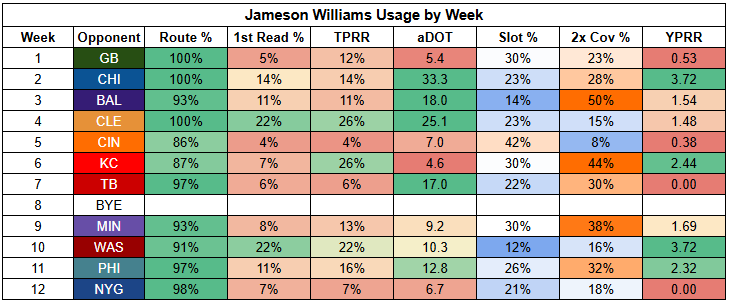
The silver lining here is that Williams turned in a 4/88/1 receiving line against the Eagles, with 2.32 YPRR, in a game where St. Brown was held to just 2/42/0.
But it's a pretty small silver lining. Even with St. Brown struggling to get open against Philadelphia, he drew 11 targets to Williams' six. In Week 1, St. Brown was held to 4/45/0 on five targets, but Williams also saw just five targets, going 4/23/0.
Williams hasn't out targeted St. Brown a single time all season. He's not really profiling as someone who steps up when the defense goes all out to shut down St. Brown. Instead, he looks like a way to play the Lions overcoming a tough matchup and rolling at home.
With the Lions as 2.5-point favorites and with a 25.5-point implied team total, that is very possible. However, there are more exciting ways to bet on the Lions being a Thanksgiving wagon.
The closest we've seen Williams come to stepping up with the offense struggling is back in Week 4, when he matched St. Brown with seven targets as Goff posted just a 33rd percentile mark in EPA per play against Cleveland. But while St. Brown turned in a 7/70/2 receiving line, Williams was held to just 2/40/0. It's possible he changes the narrative here, but with Goff in a low-floor matchup, Williams is just a WR4.
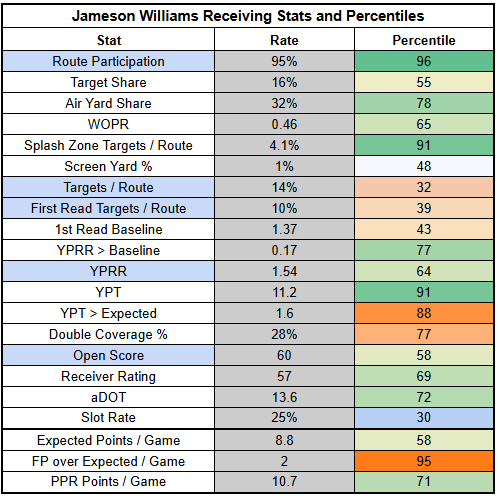
St. Brown is in a tough spot, but also has the decided benefit of being the engine of the downfield passing game. That's even more true with Sam LaPorta out. St. Brown is a high-end WR1.
Behind St. Brown, Williams might be the No. 2 downfield option, but Jahmyr Gibbs looks like the true secondary receiver—especially in a matchup where Goff will need to get the ball out quickly.
In Week 1, we saw the Lions heavily utilize Jahmyr Gibbs as a check-down option. This week, they'll likely be more proactive in getting him involved.
Despite seeing a 28% target share in Week 1, Gibbs had just a 4% first-read target rate. He was seeing dump-off targets, targets that represented a failure of the called play, rather than targets designed to get him into space.
This has changed massively under Dan Campbell. Arguably, it's the biggest change we've seen since he's taken over play calling. Gibbs has posted his three highest first-read target rates of the year over the last three weeks, including elite rates in his massive spike weeks against the Commanders and Giants.
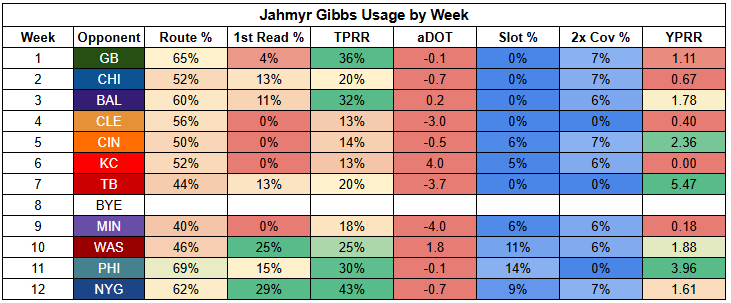
If we think of Gibbs purely as a receiving running back, his per-route profile is on par with Christian McCaffrey's and much stronger than De'Von Achane's. In this matchup, we're likely to see the Lions lean on Gibbs in the receiving game once again.

With LaPorta out, Brock Wright has been operating as the starting tight end. But Wright will now miss this game with a neck injury.

This leaves Ross Dwelley in line to start at tight end. Dwelley has barely played this year, but he's been in the league since 2018, so we at least have some data on him. However, we have to go back to 2022 to find a season with more than one target, and to 2020 to find one with more than five targets.
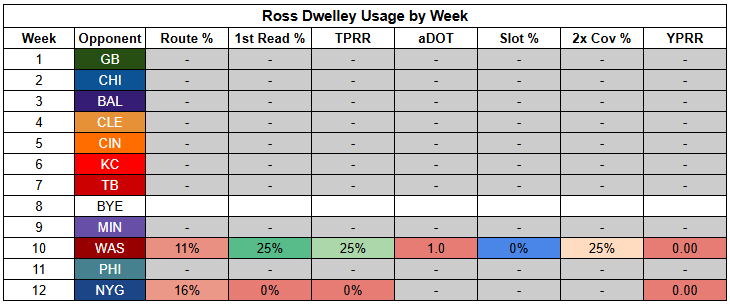
With a career TPRR of 11% and a career YPRR of 1.03, he's likely to be pretty Brock Wright-esque, if not worse.
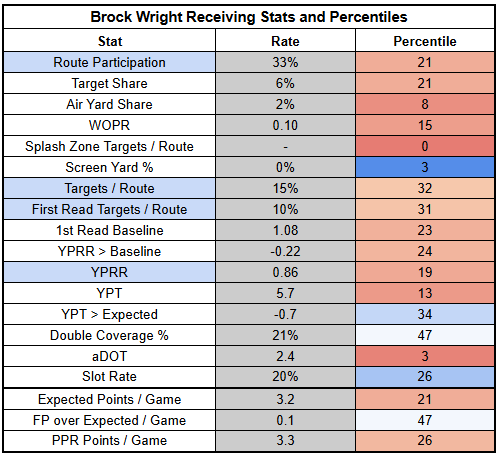
Dwelley probably won't have the full Brock Wright role, but I think he gets reasonably close. He's seen offensive snaps in eight games this year, logging 53 snaps on offense. Last week was the first time Anthony Firkser has been active in 2025 and he played just three snaps. Firkser has played just 67 total offensive snaps over the last three seasons. I'm guessing the Lions are more comfortable with Dwelley. He's a TE3.
Kalif Raymond has been unable to practice due to an ankle injury and is out for this game.
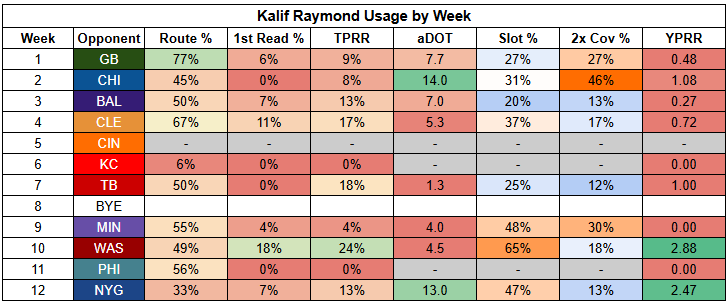
That should cement more routes for Isaac TeSlaa. But while I can promise you more routes for TeSlaa, targets are another thing entirely. TeSlaa is also listed questionable with a hand injury after being limited all week.
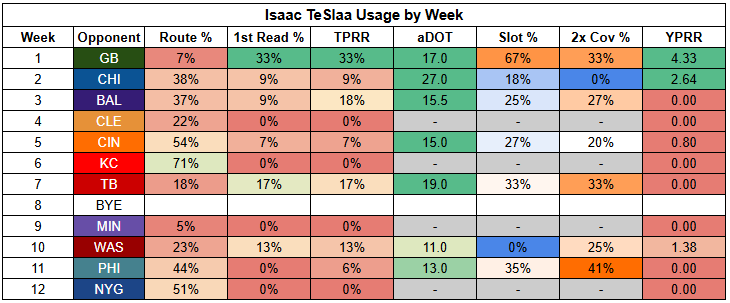
After looking at TeSlaa as the No. 3 WR and Dwelley as the starting tight end... it's hard not to get excited about the potential for St. Brown and Gibbs to rack up targets here. The lack of depth may even drive more targets to Jameson Williams.

Like Jameson Williams, TeSlaa and Dwelley are primarily bets on the Lions having strong passing production. Because if Goff is struggling in a competitive game, the Lions are likely to shift to the run.
The Lions ran the ball on the Packers in Week 1, relative to game script. But they gave up a touchdown on the opening drive and trailed by at least seven points for the rest of the game, losing 27-13.
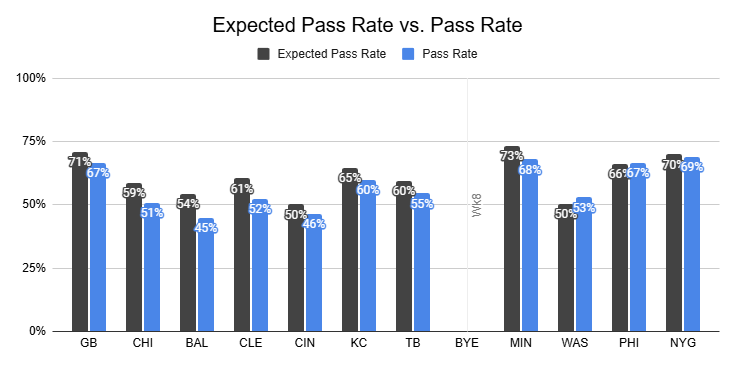
We'll likely see a more balanced effort in the early going this week, more in line with the Lions' identity.

A run-first approach would also fit with how teams have been attacking the Packers, especially in recent weeks.
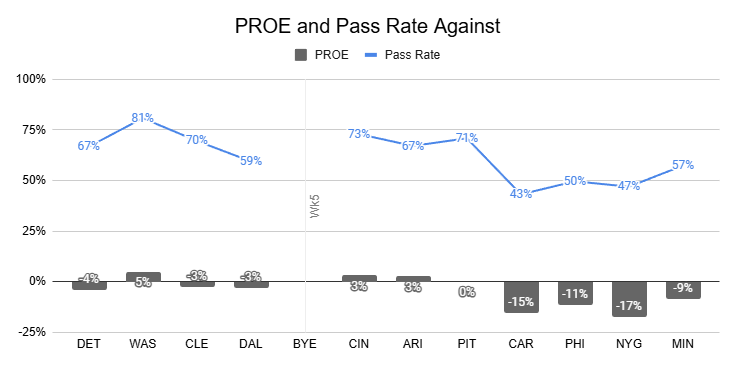
The Packers are good enough to keep teams from running on them at excessively high rates, but they still profile as a run funnel.

The Packers aren't bad against the run, but they are far better against the pass. The Packers are also very conservative on offense, allowing run-heavy opponents to hang around. It makes sense to pivot to the run here, especially if the passing game isn't clicking.

As noted above, Jahmyr Gibbs is likely to be a big part of the passing game plan this week. But he'll also be a focal point in the run game. After saying that he wanted to get David Montgomery more carries last week, Dan Campbell showed us how he really felt about his backfield with the game on the line, giving Gibbs a season-high 75% carry share.

Gibbs only had 15 carries; it's not like he was a rushing workhorse against the Giants. But considering that Gibbs also had 11 (!) receptions, his 15 carries to Montgomery's five were a bit of a statement.
In all likelihood, we'll see Montgomery get more work than he did last week. I highly doubt the plan was for him to have just eight touches last week. We'll likely see him more in the 40% carry share range.
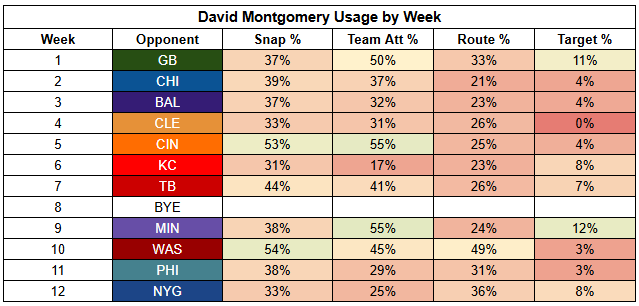
At the same time, this looks like a matchup where the Lions genuinely need Gibbs. Honestly, when writing this matchup up, my initial reaction was—man... how do the Lions overcome this defensive matchup? I eventually landed on—oh, right, Jahmyr Gibbs.
Gibbs is an elite RB1.
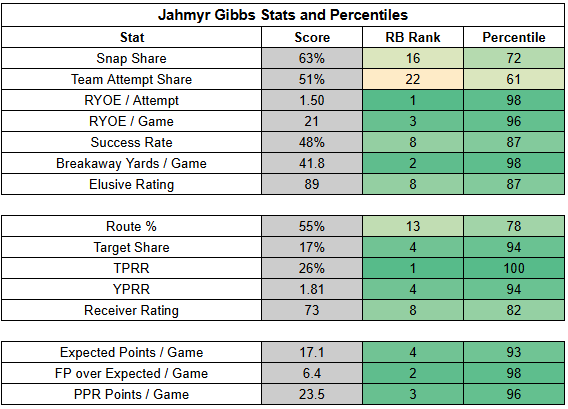
Montgomery should see his workload increase a bit here, but he's a fragile play with a TD-dependent ceiling. He's an RB3.
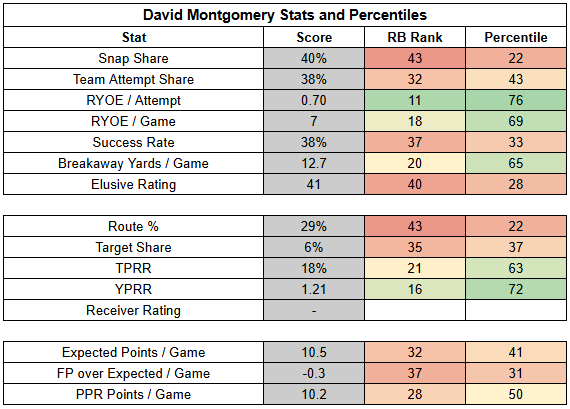
Chiefs at Cowboys, 4:30 PM
Chiefs
Implied Team Total: 27.75
Earlier in the season, the Cowboys profiled as one of the easiest passing matchups in the NFL. And, by the season-long numbers, they still look extremely vulnerable, profiling as one of the worst coverage units in the league.
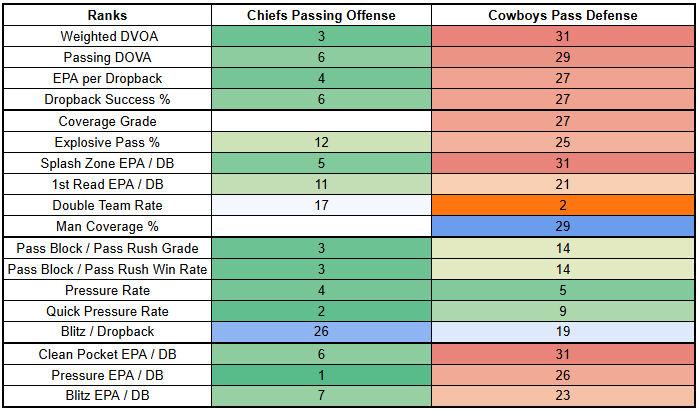
However, the Cowboys' pass rush is shaping into a genuinely disruptive unit, especially since acquiring Quinnen Williams.
On the Jets, Williams was profiling as an elite run stuffer, but it was fair to wonder if he'd fallen off as a pass rusher after excelling there in previous years. But he's up to DT14 in pass rush win rate after racking up pressures in two games with the Cowboys.
QB Pressures since NFL trade deadline
— Pat Thorman (@Pat_Thorman) November 25, 2025
1. Miles Garrett (18)
2. Josh Hines-Allen (16)
3. Quinnen Williams (15)
.
.
.
.
.
12. Micah Parsons (10) pic.twitter.com/RbjNF8b0QN
DT Osa Odighizuwa is also pressuring well, ranking DT9 in pass rush win rate.
Meanwhile, the Chiefs will be without RG Trey Smith. Smith will be replaced by Mike Caliendo, who has been a liability in pass protection.
We can count on the Cowboys to generate some pressure here.
That's not an ideal setup for Patrick Mahomes, who has been in a bit of a mini slump over the last three weeks. Mahomes did bounce back a bit last week, doing just enough to beat the Colts.

When going under the hood, pressure doesn't look like the big issue for Mahomes. The Chiefs rank first in EPA per pressured dropback. He's avoiding sacks well and is rarely blitzed. The Cowboys don't blitz much and will rely on four-man pressure against Mahomes.
Mahomes looks more than capable of handling a solid pass rush. The bigger issue has been identifying a target quickly. Mahomes is attempting a first-read throw on just 53% of his dropbacks, and has been more efficient on non-first-read throws than on first reads. Jaxson Dart is the only other QB with positive EPA in both buckets who is more efficient on non-first-reads.
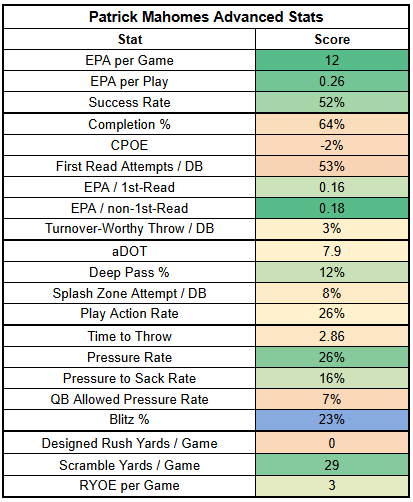
This tells us that Mahomes has been forced to make plays outside of structure this year.
Other data backs this up. Mahomes ranks QB17 in EPA per play on quick dropbacks (2.5 seconds or less) this year. From Weeks 1-6, without Rashee Rice, he ranked QB23.
Then, Rice returned, and Mahomes jumped to QB6 in Weeks 7-8, posting two of his three most efficient games of the year overall.
However, over the last three games, Mahomes has fallen to just QB28 on quick dropbacks.
The Bills hit Rashee Rice with a 39% double coverage rate, limiting Mahomes ability to lean on his underneath safety blanket.
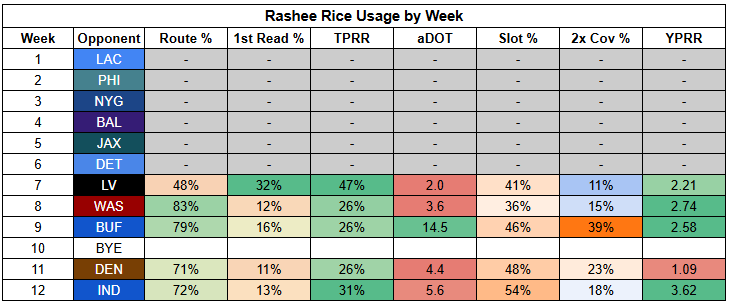
Mahomes then faced the Broncos and Colts, who have elite secondaries.
This week, we're looking at a huge downshift in secondary talent and a Cowboys defense that operates almost entirely in zone.
Against man coverage this year, Rice has a 21% TPRR with just 0.90 YPRR. But against zone, Rice has a 32% TPRR with 3.44 YPRR.
Over the last three games, the Chiefs have faced zone coverage rates of 63%, 71%, and 53%. The Cowboys have a 79% zone coverage rate this year, and are at 89% since their Week 10 bye.
For Rashee Rice, this is pretty ideal. Even when facing double coverage within zone coverage schemes, he has a 21% TPRR with 3.52 YPRR. The Cowboys double cover at a high rate and will focus on limiting Rice as much as possible.
But this matchup still sets Rice up for a very strong day—a potential return to the pace he initially set after his return from suspension. Because even with Mahomes not operating at peak efficiency over the last three games, the Chiefs have still been passing at a high rate. Last week, they posted a negative PROE, but still turned in a league-average pass rate. If Mahomes returns to form here and/or the Cowboys push the Chiefs... we could be looking at a rare combination of volume and efficiency.

If Rice can overcome some double coverage in an otherwise ideal matchup for his skillset, there's enormous upside here. Rice is an elite WR1.
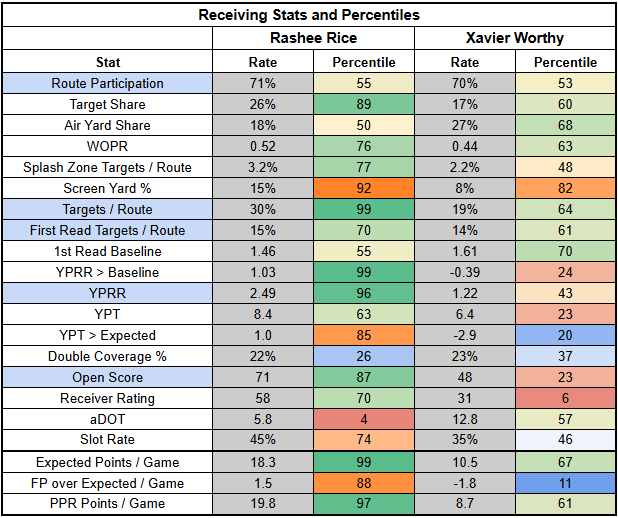
Xavier Worthy has also had issues against man coverage; he has a strong 24% TPRR but just 1.36 YPRR. Unfortunately, he's been even worse against zone, with a 19% TPRR and 1.30 YPRR.
Worthy's best bet is that Mahomes gets rolling here against a weak Cowboys secondary with an in-rhythm passing attack. Rice will probably be the one powering that type of offense. But Worthy can operate as a counterpunch... with the power behind the punch coming from the most efficient QB in the NFL.
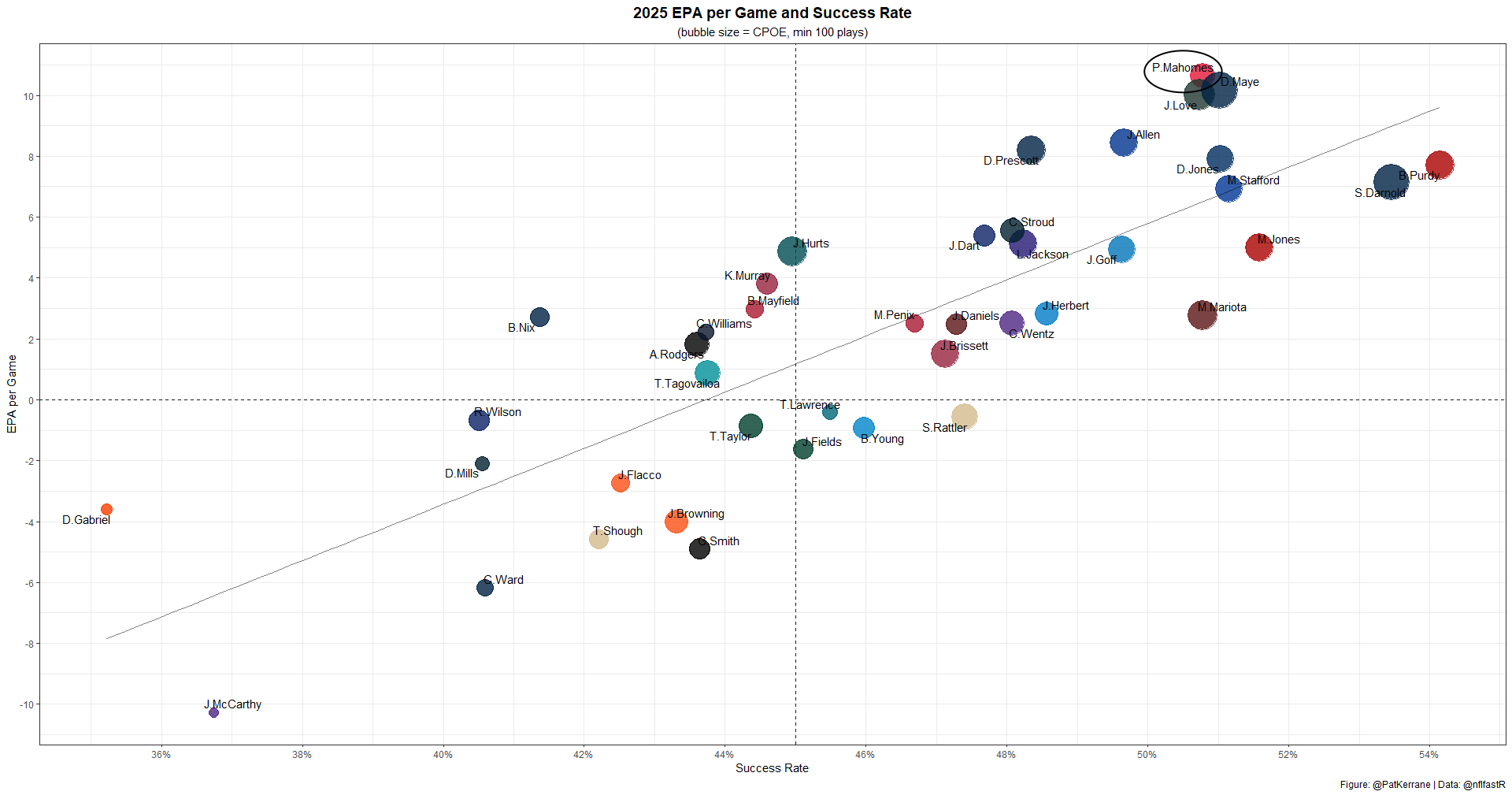
Worthy has struggled since Rice has returned, but mostly because he's struggled... the entire year. He has some matchup-related upside, but is just a WR4.
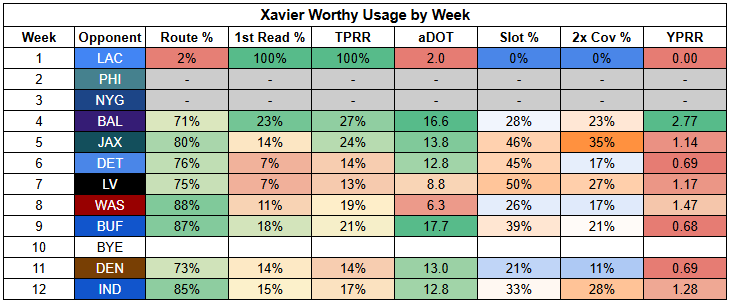
Travis Kelce posted a 33% TPRR against the Broncos, who successfully shut down Rice. But he's posted very weak target rates in the other four games since Rice's return.

The silver lining is that Kelce has been better against zone than man, with a 20% TPRR and 2.13 YPRR against zone, but just 16% and 1.29 against man. As a bet on Mahomes taking advantage of a weak secondary, Kelce is a high-end TE1.
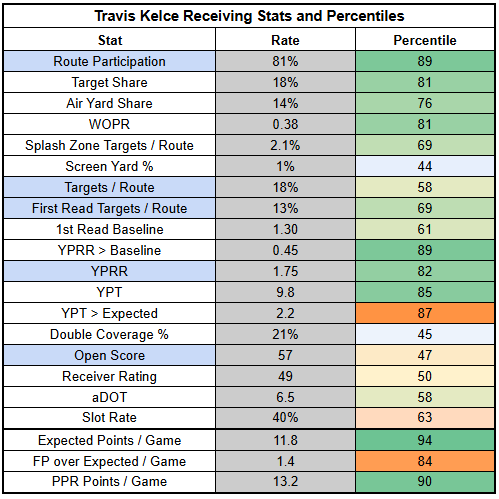
One issue for Worthy and Kelce is that the passing game is pretty spread out. Rice is generally able to consolidate targets, but Worthy and Kelce are dealing with Hollywood Brown, Tyquan Thornton, and Juju Smith-Schuster, all of whom are continuing to mix in. Individually, all three are very shaky plays; collectively, they lower the floor for the Chiefs' top three receivers.
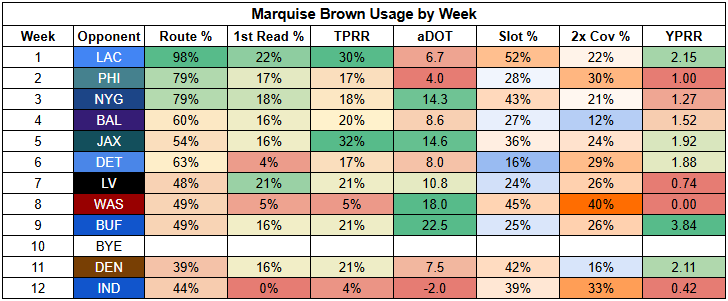
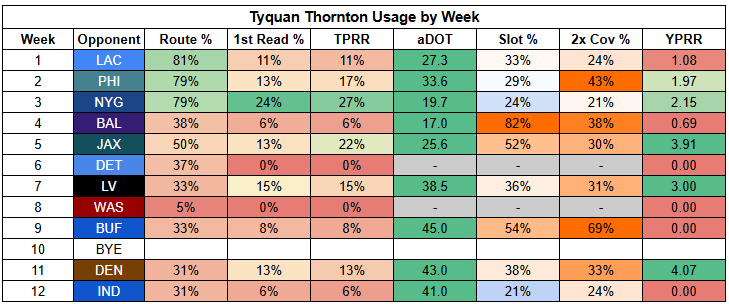
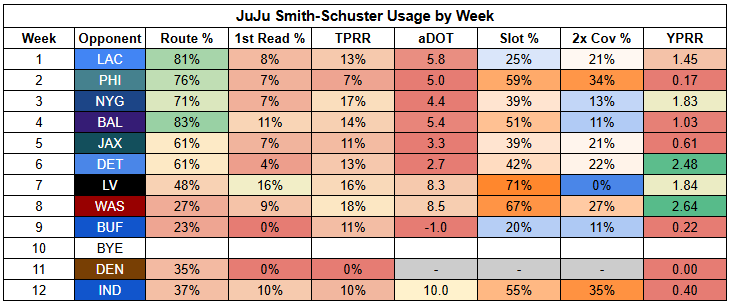
In the backfield, we can expect things to be even more split up. There, we just have a three-way split, without a clear leader in the clubhouse.
Isaiah Pacheco practiced in full all week and will return for this game, likely forming a split with Kareem Hunt.

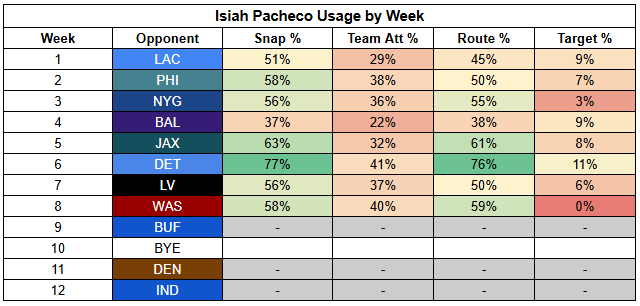
However, even when Pacheco was healthy, Brashard Smith was seeing work. He's unlikely to be phased out.
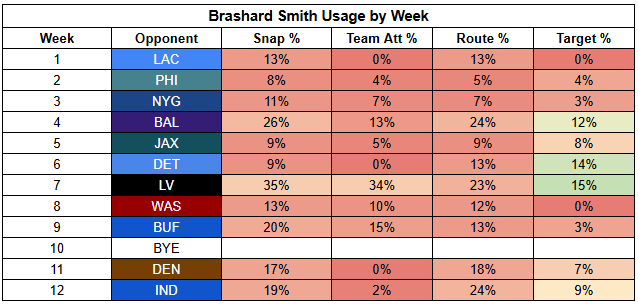
The split workload is a major issue. But the biggest problem with the Chiefs' backfield is that no one looks to have any juice.
This very much includes Pacheco.

Kareem Hunt has been a much better short-yardage runner and is delivering an elite success rate. Hunt is my preferred play here even with Pachco back, but he's just an RB4 as a bet on a TD.
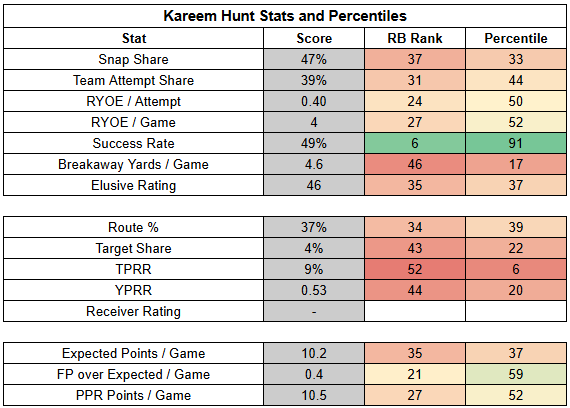
Against a Cowboys run defense that isn't good... but is better since the addition of Quinnen Williams, Pacheco is also in the RB4 mix.

Cowboys
Implied Team Total: 24.25
Dak Prescott is coming off a very difficult matchup against the Eagles, but he turned in a decent performance.

For the second straight week, Prescott was powered not by CeeDee Lamb, but by George Pickens, who went off for 9/146/1 against the Eagles.
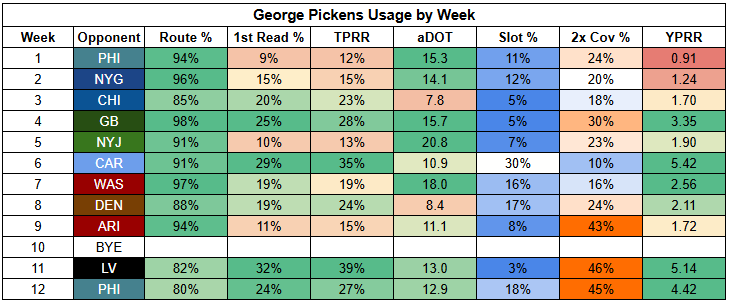
Pickens dealt with quite a bit of double coverage, but also benefited from going against Adoree' Jackson—one of the weakest corners in the league—at a high rate.
This week, the Cowboys face a Chiefs defense that also has a weakness in coverage: Chamarri Conner. Among 199 defensive backs with 200+ coverage snaps, Conner ranks just 173rd in yards allowed per coverage snap. Conner is listed as a safety, but he's worse on dropbacks with a WR target, falling to 179th.
Unlike Jackson, an outside corner, Conner aligns mostly in the slot or at safety. Lamb is more likely to face him than Pickens.

Overall, the Chiefs have been strong in coverage, limiting big plays and first-read efficiency.
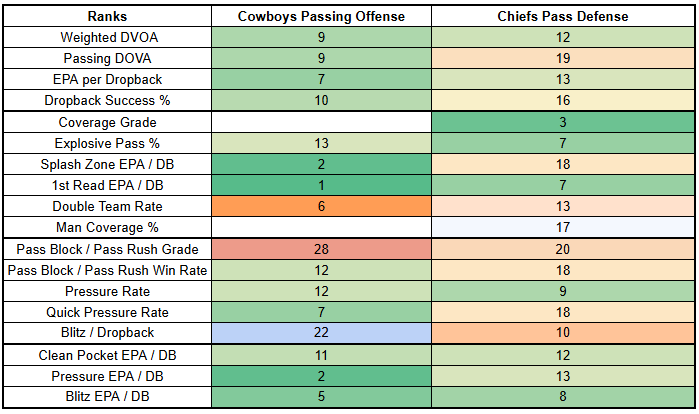
First-read success has been a key factor for Prescott this year, which makes sense, considering that he has two No. 1-level WRs.
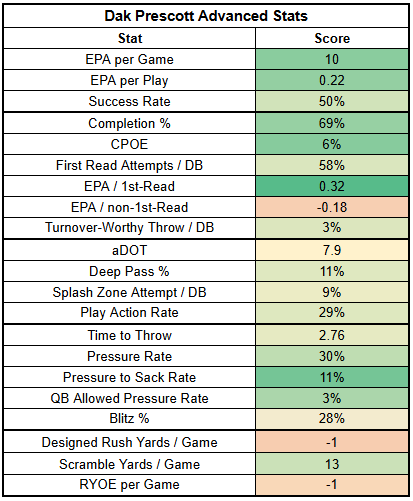
Prescott's weapons have helped him rebound strongly from a down 2024, not just on his first look, but overall. He ranks QB5 in EPA per game and QB13 in success rate.
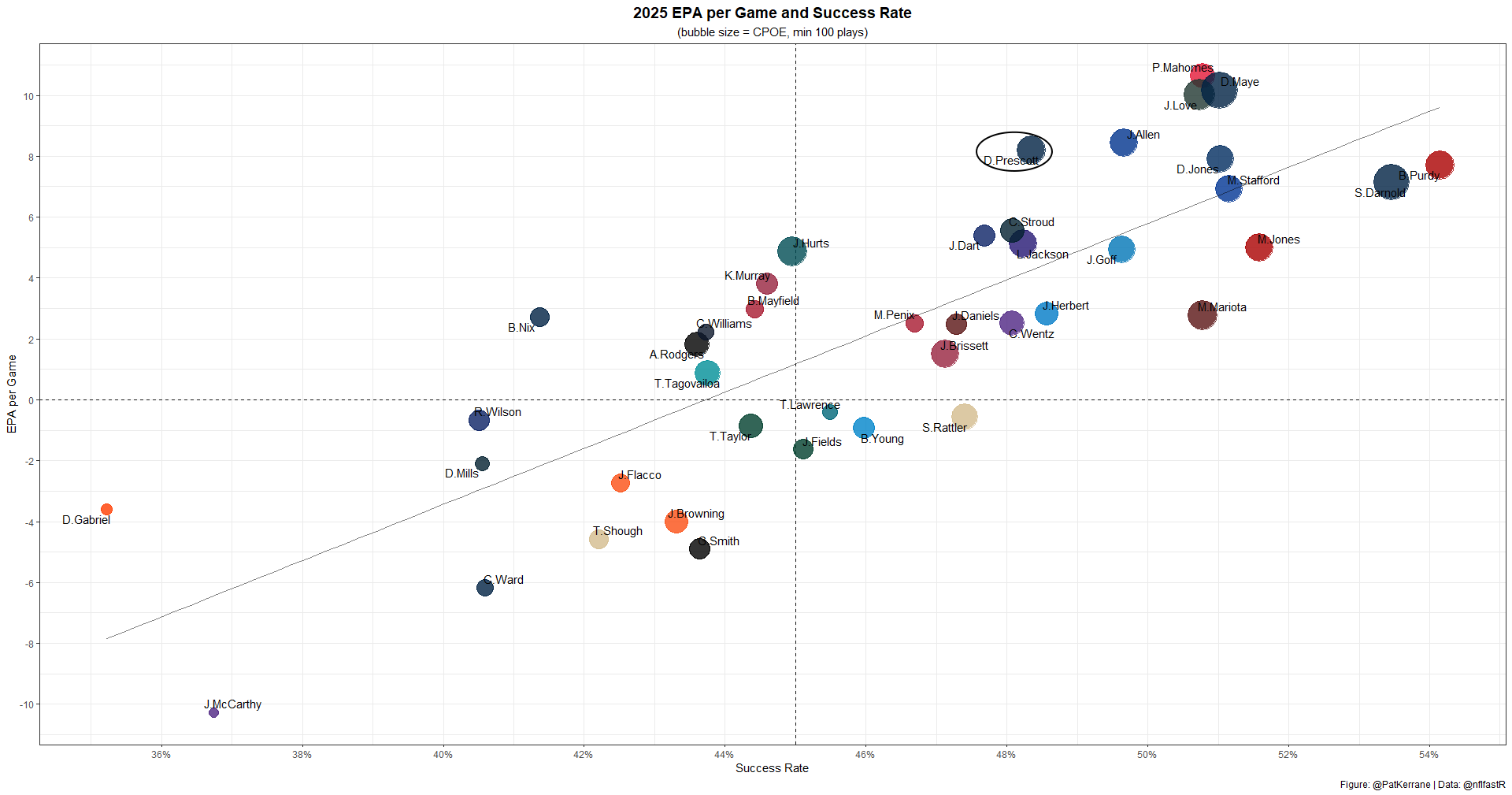
With both Lamb and Pickens playing like true No. 1 options, Steve Spagnuolo is going to have his hands full trying to take away Prescott's first option.
Both WRs are already seeing high double coverage rates, but are still getting open and delivering very strong efficiency.
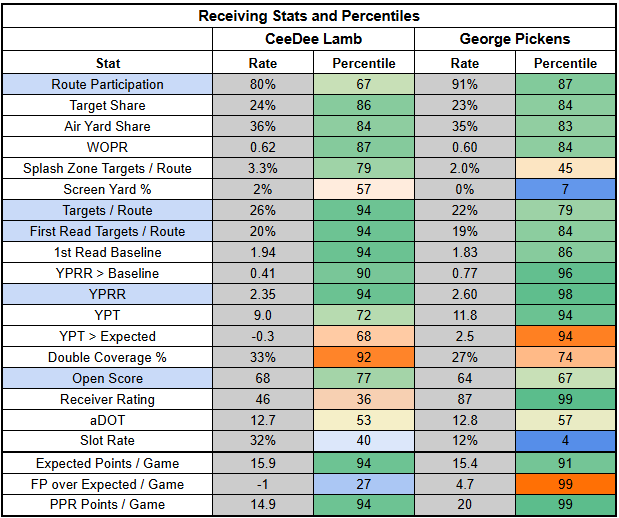
Brian Schottenheimer doesn't look likely to back away from a fight here, either. If, as 3.5-point home underdogs, the Cowboys fall behind, they are likely to pass as needed to stay in contention.

With a 1% PROE and 64% pass rate, the Cowboys aren't pass-heavy. But they're also very comfortable in high-pass-rate environments.

With CeeDee Lamb likely seeing some easier matchups out of the slot and the Chiefs unable to fully focus on him, he profiles as a high-end WR1.
Pickens has been an absolute star recently, but this matchup slightly dings his outlook, as he will face the brunt of the Chiefs' solid outside cornerback duo. He's a WR1.
Behind the Cowboys' top two WRs, KaVontae Turpin and Ryan Flournoy are in a split role. Turpin looks slightly more interesting as a bet on some gadget usage.
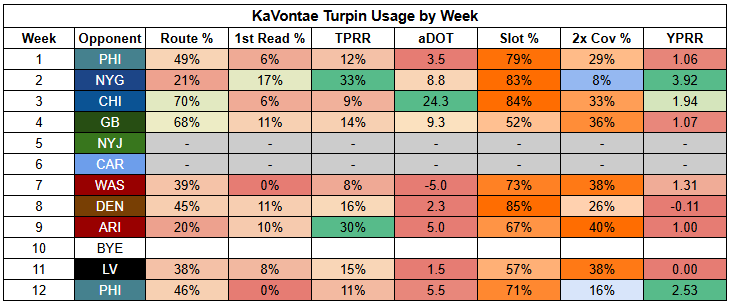
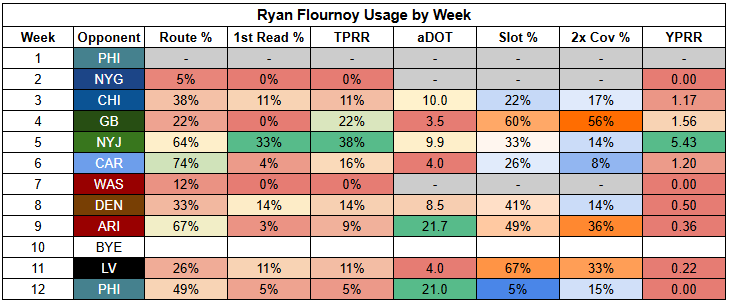
Jake Ferguson will be operating as the true No. 3 option in the passing game. He's been quiet recently, but showed a little life against the Eagles with a 5/60/0 on six targets.
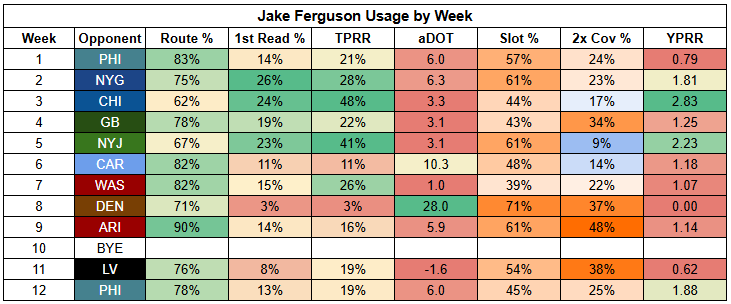
Ferguson's season-long numbers overstate his recent role in the offense—by a lot. Pickens' emergence has come mainly at his expense. Still, he's still earning targets at a reasonable rate and is in the game with the highest total (52.5) of the week. He's a TE1.

In the backfield, Javonte Williams continues to dominate touches.
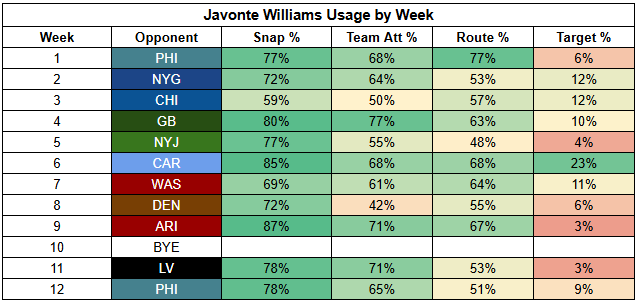
Williams wasn't great against the Eagles. On 20 attempts, he turned in 87 yards, zero RYOE and just a 35% success rate. Williams' season-long numbers still look strong, though.
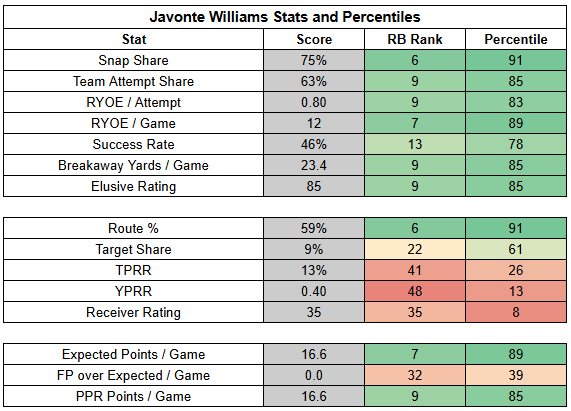
Unfortunately, Williams gets another tough rushing matchup. The Chiefs just limited Jonathan Taylor to 58 yards, his second-lowest rushing total of the year.

The Chiefs pass at a consistently high rate and, with a 27.75-point implied team total, are very likely to push the Cowboys here. That's likely to limit Williams' rushing volume in a matchup where efficiency could be an issue.

Then again, the Chiefs' primary focus is likely to be shutting down the passing game. And Williams is at home and facing a defense coming off a do-or-die matchup on a short week. Williams is also attached to a strong passing game and is part of an offense with a strong 24.25-point implied team total. He's a TD-dependent bet, but there's definitely TD equity here. Williams is a high-end RB2.
Bengals at Ravens, 8:20 PM
Bengals
Implied Team Total: 22.5
Joe Burrow is set to return this week, after being lost to a toe injury back in Week 2. Burrow didn't play particularly well to start the year, disappointing in a difficult matchup against the Browns, but also struggling against an unimpressive Jaguars pass defense.
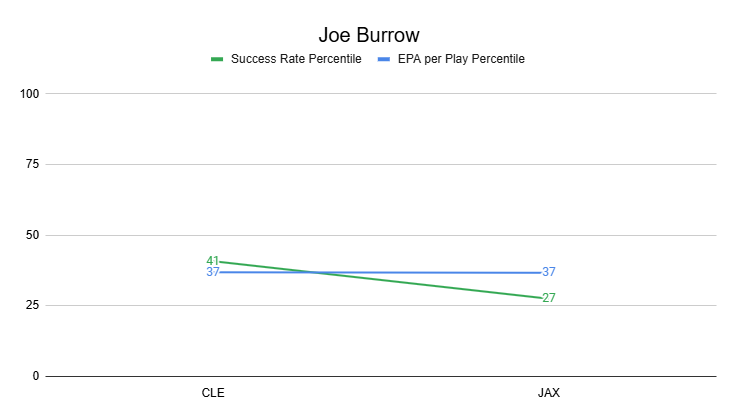
Even still, Burrow still has the best season-long efficiency among the three QBs on the Bengals roster.
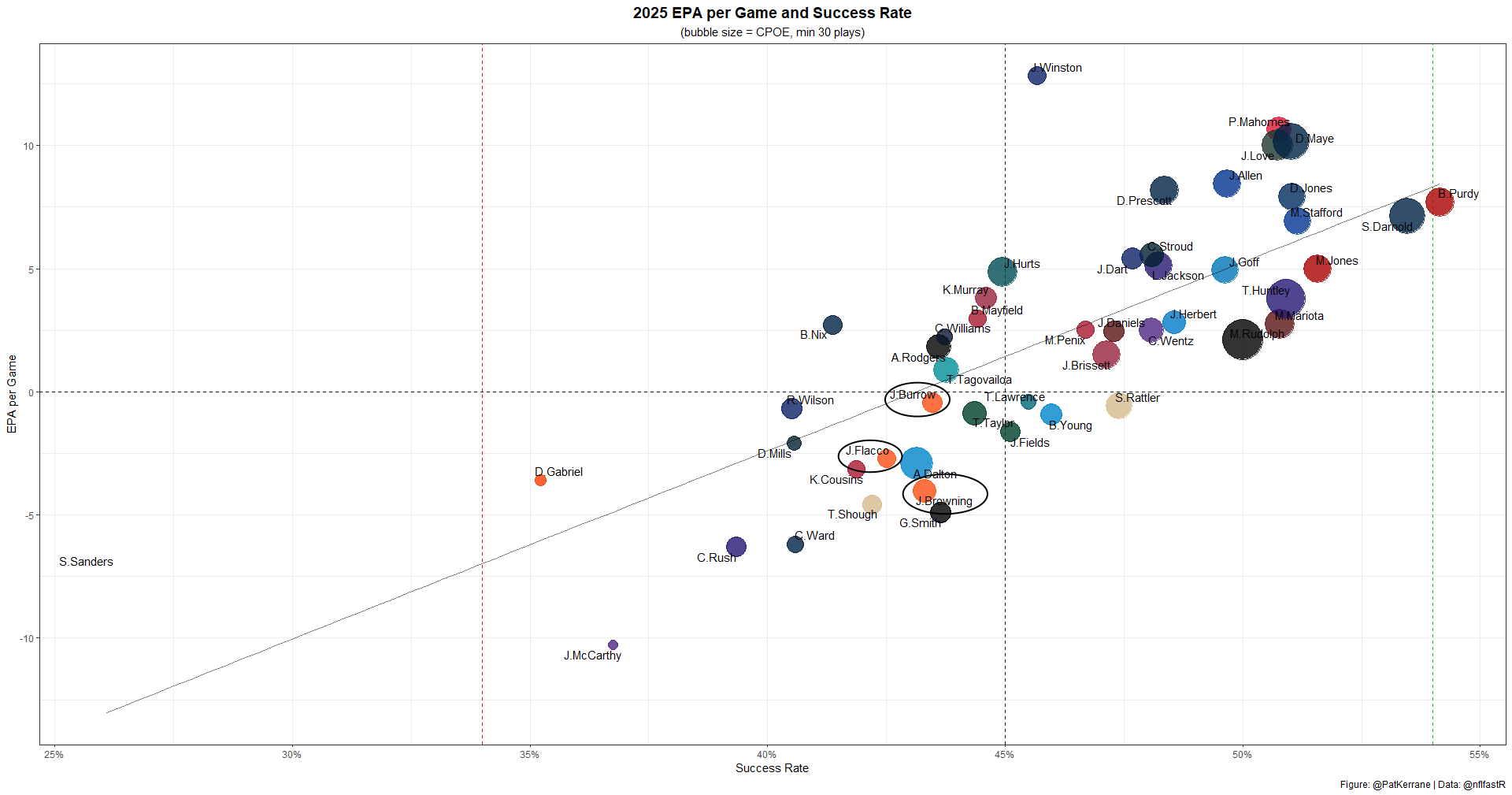
Joe Flacco injected some life into the Bengals' passing game for a few weeks, but he has had back-to-back duds. Even if Burrow isn't at his best, he's a very safe bet to improve the QB situation in Cincinnati.

And, obviously, a couple of bad showings to start the year don't change the fact that we're talking about Joe Burrow.
He turned in an MVP-caliber season last year and substantially raises the ceiling of this offense.

Burrow also allows the Bengals to play the way they want to. After a pass-heavy start to the Flacco era, Zac Taylor was more conservative over the last two weeks.
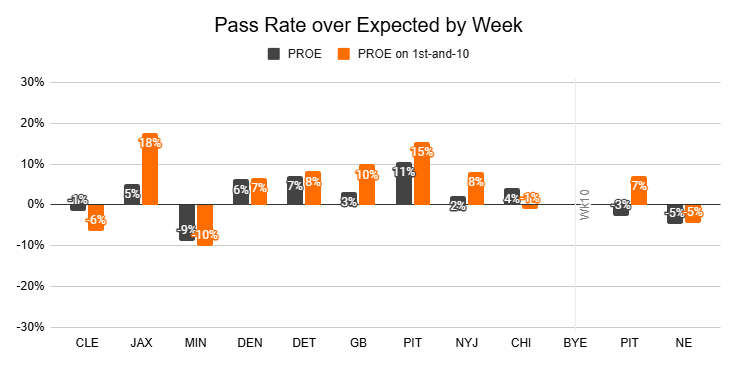
The Bengals' defense is bad enough that, even with PROEs of -3% and -5% over the last two weeks, the Bengals still posted pass rates of 66% and 62%. This puts them at a league-average pass rate or above in ever game with Flacco.
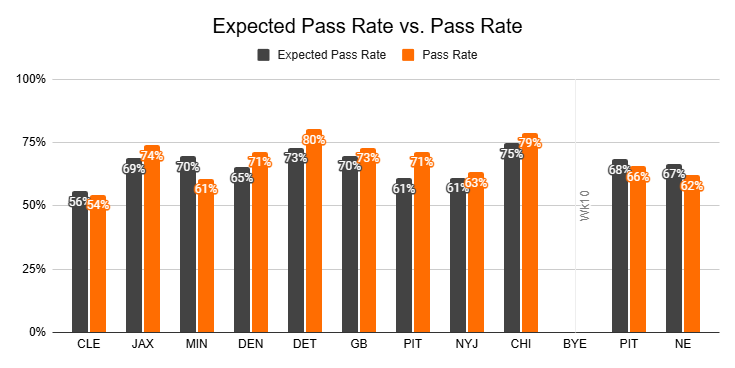
With Burrow back at the helm, we could see the Bengals attack through the air, rather than simply respond with a pass-heavy approach in negative game script.
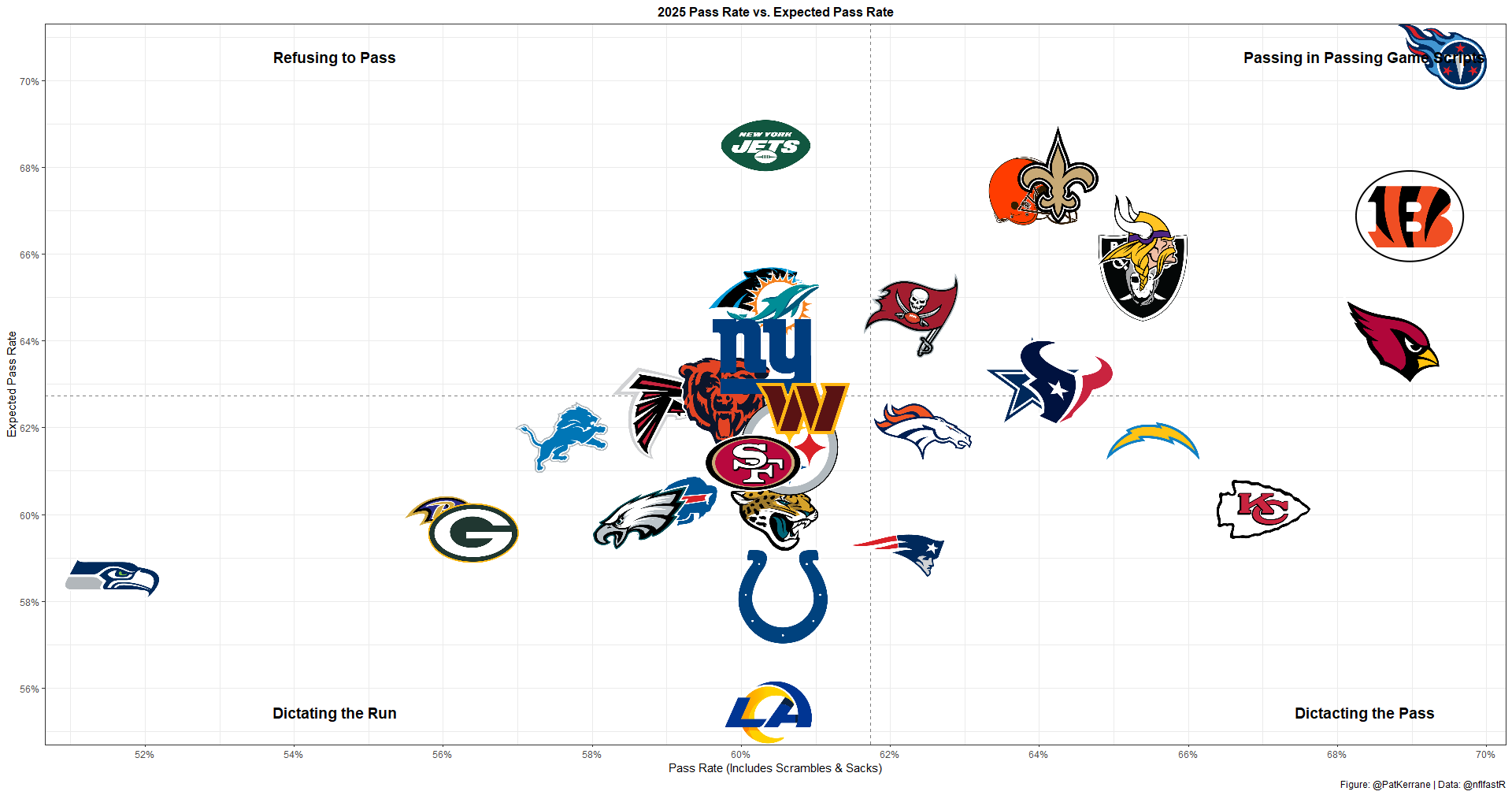
Unfortunately, Burrow will still be playing behind a very poor Bengals offensive line.
The good news is that the line could be slightly better this week than it has been. Rookie RG Jalen Rivers has been a disaster in pass protection this year, and after injuring his ankle in Week 11, he was replaced by Dalton Risner, who has been solid. Last week, Risner played every snap at right guard, so he's presumably the starter this week, providing a slight boost over the rookie.
More importantly, the Ravens' pass rush remains very weak. Dre'Mont Jones has provided a little juice after joining the team. And Kyle Hamilton—who is good to go after suffering an ankle injury against the Jets—is a movable chess piece who can be used to pressure the passer. But the pass rush hasn't recovered from losing Nnamdi Madubuike, Broderick Washington, and Tavius Robinson to injuries and then trading away Odafe Oweh.

The Ravens are much stronger in coverage than in generating pressure. But they don't double-cover at a very high rate, which is good news for Ja'Marr Chase, who will, very obviously, operate as the focal point this week with Tee Higgins out.
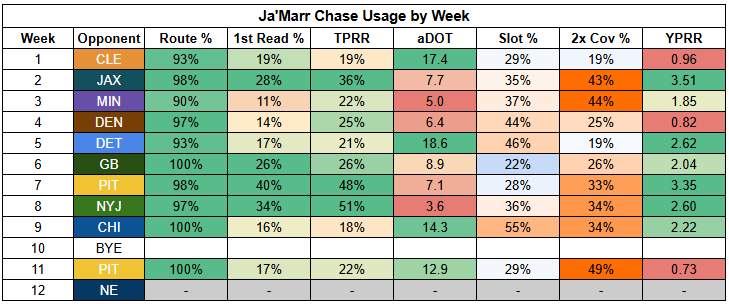
Higgins was in a bit of a different role with Chase out last week, seeing more shallow targets. But with Chase on the field, he has consistently operated as a field stretcher, drawing double coverage as well as targets.
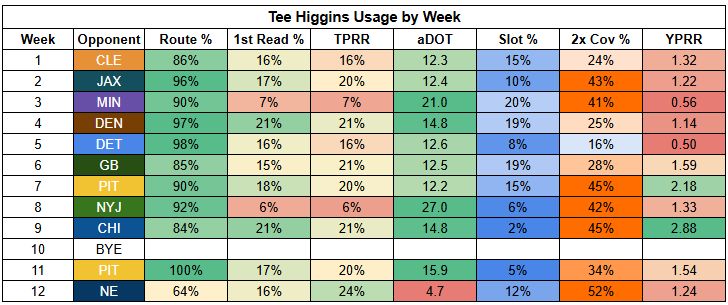
Higgins absence will likely make the Bengals less threatening downfield and more predictable. But it's hard to shut down Chase, even if you know the Bengals plan to feed him. Chase is an elite WR1.
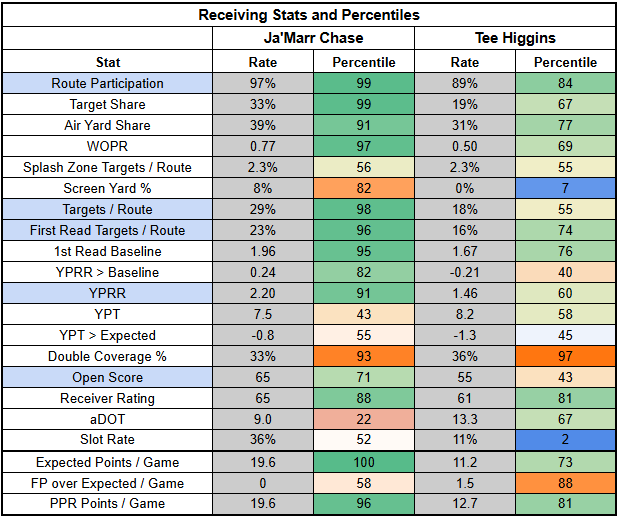
With Higgins out, Mitchell Tinsley will likely be the Bengals' dedicated field stretcher. He saw playing time throughout last week's game, not just after Higgins was concussed; he'll likely be in a similar role this week. He's in play as a Thanksgiving slate dart throw.
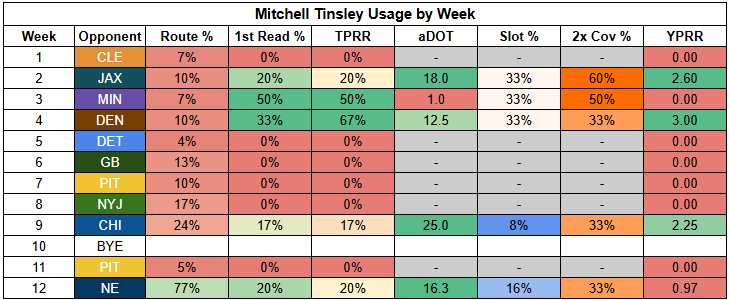
Andrei Iosivas saw more work on the outside last week, helping fill in for Higgins, who was concussed early in the 4th quarter.
He'll likely spend some time on the outside this week, allowing Chase to rotate into the slot. But Chase primarily plays on the outside, so Iosivas will likely be in something roughly resembling his regular role.
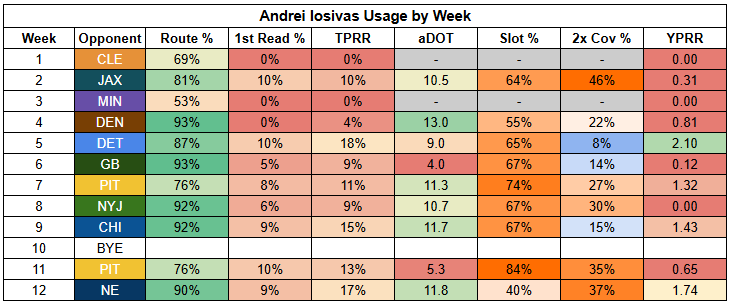
Unfortunately, Iosivas' regular role is pretty damn weak. He's just a dart throw.

Mike Gesicki returned last week, and even off of injured reserve, saw his usual bump in usage with either Chase or Higgins out of the lineup.

This coincided with Noah Fant barely playing.

In fact, Tanner Hudson operated as the secondary tight end.
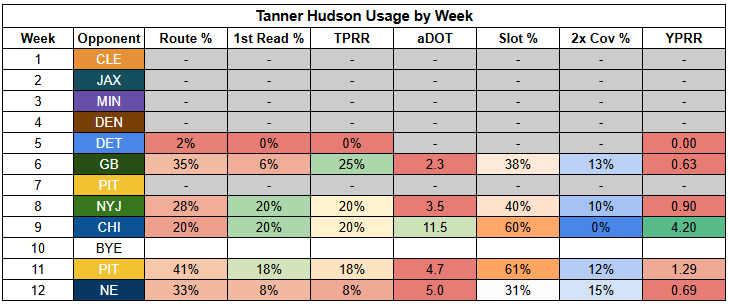
Gesicki has peaked at just 1.35 YPRR this year, so it's tough to get overly excited about him. However, he's likely to draw targets with Higgins out and should post well over 50% route participation. He's a high-end TE2.
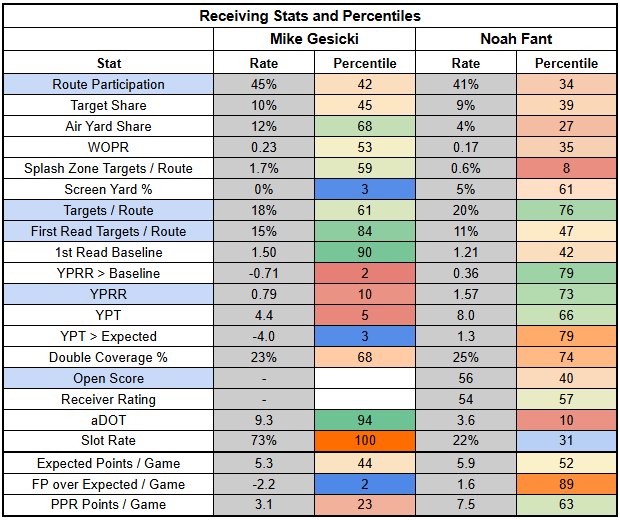
In the backfield, Samaje Perine is off the injury report and will return, which will impact Chase Brown's workload. Brown has been dominating touches since Perine was hurt, but Perine was siphoning off valuable work prior to Week 9.
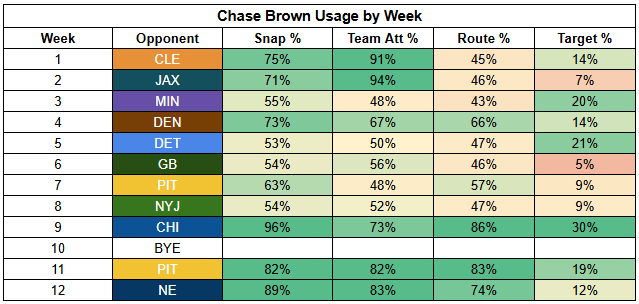

Brown hasn't been very efficient this year. The Bengals are willing to trust him when they don't have anyone else they can trust... but with Perine back, he looks far less interesting in a D'Andre Swift-style starting role than as an every-down back.
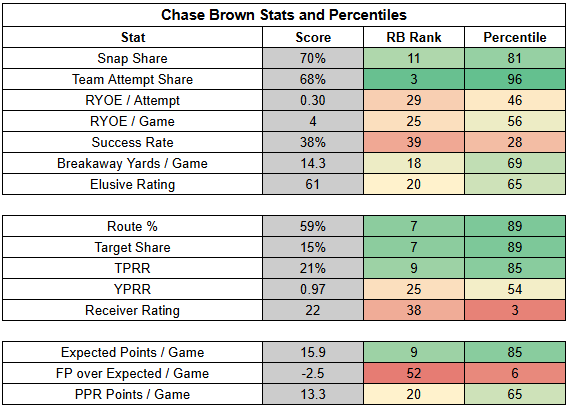
Chase will be going against a mediocre Ravens run defense, though. And he gets a boost from Burrow's return. He's an RB2.

Ravens
Implied Team Total: 29
Lamar Jackson started the week on the injury report with a toe injury. He's since logged two full practices and doesn't carry an injury designation. But, I note the initial DNP because Jackson doesn't appear to be 100% right now. He wasn't bad last week, but against a very beatable Jets defense, he was far less impactful than we'd typically expect.
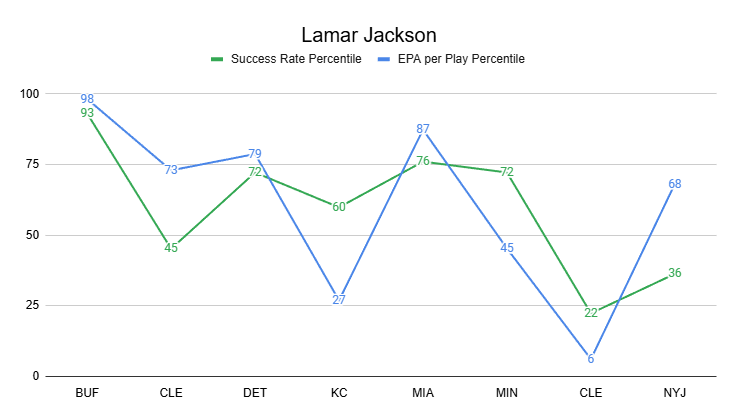
Likewise, Jackson hasn't been bad this year; he just hasn't been the force of nature we've come to expect. Jackson ranks a respectable QB12 in EPA per game and QB14 in success rate.
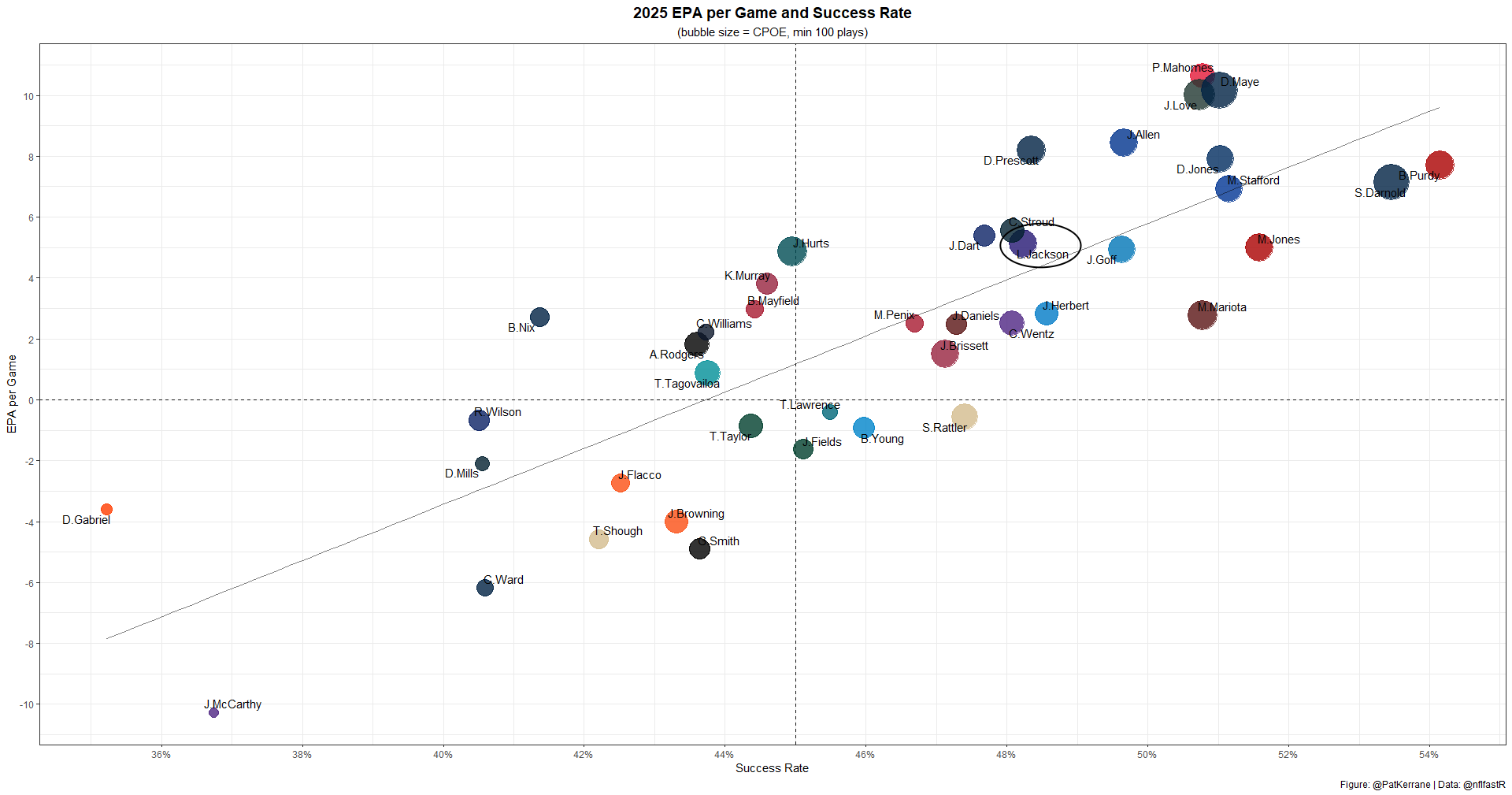
Pressure has been more of an issue for Jackson than usual this year. He's taking a long time to throw. But that's typical. What isn't typical is that Jackson is suffering the consequences that normal quarterbacks do when they hang onto the ball for a long time. He's taking sacks and not adding a ton of yards as a scrambler.
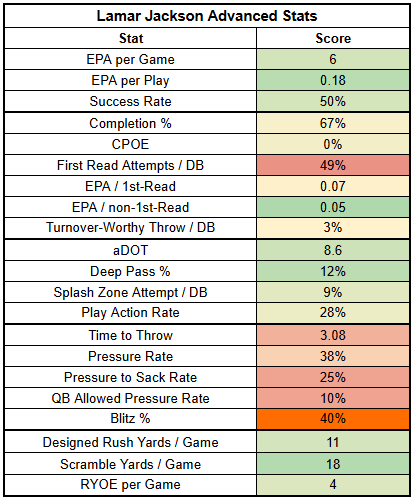
Jackson isn't fully Jackson right now, which makes him a bit matchup dependent. If we want him to go off, we probably need an exceptionally weak pass rush. A weak coverage unit wouldn't hurt, either.
On Thanksgiving, Jackson gets a double serving of defensive ineptitude. The Bengals are very poor in coverage and aren't pressuring opposing QBs—especially without Trey Hendrickson, who is out again this week.
While playing the Bengals last week, the Patriots lost LT Will Campbell, their best offensive lineman. They also lost starting LG Jared Wilson earlier in the game. The Bengals still posted just an 18% quick pressure rate, well below the league average (22%). The Ravens' offensive line hasn't been amazing this year, but they should still be just fine in this matchup.
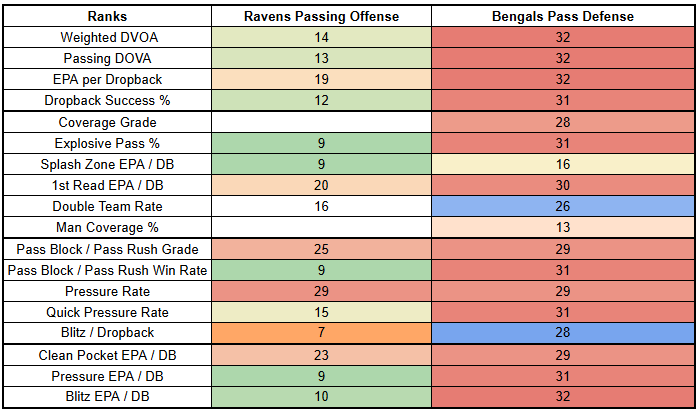
But efficiency isn't the only question for Jackson here. Volume could also be an issue. On that front, Joe Burrow's health is a significant factor. If the Bengals can push the Ravens, this profiles as a potential rebound spot for Jackson.
However, if the Ravens play consistently from ahead here, they are likely to attack a Bengals run defense that has also been extremely weak.

Since Jackson's Week 9 return against the Dolphins, the Ravens have peaked at just a 55% pass rate, delivering negative PROEs over the last two weeks to get there.
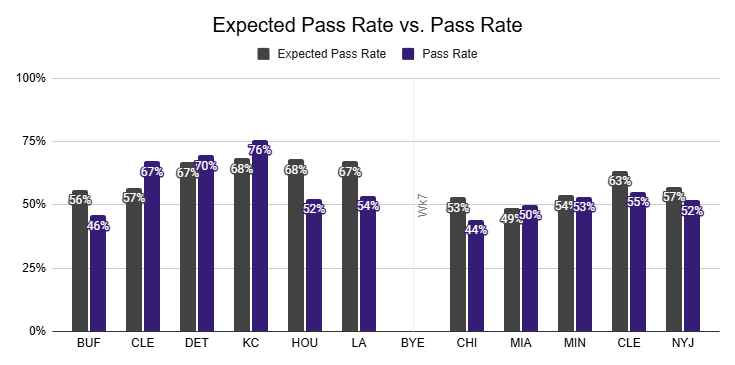
Derrick Henry scored two TDs against the Jets, but he still had a bit of an underwhelming rushing day, turning 21 carries into just 64 yards with -6 RYOE and a very weak 14% success rate.
This looks like a potential get-right spot for Henry as well, though. Although he's had a poor success rate all season, he's still proven to be explosive. Against a weak Bengals defense, he has upside for rushing efficiency and TD production.
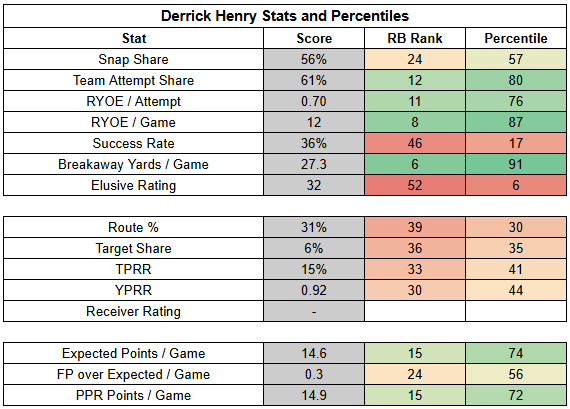
It was also nice to see Henry somewhat involved as a receiver last week, adding two receptions for 24 yards, even with Justice Hill back in the lineup.
If this game turns into a legitimate shootout, we could see Henry phased out. But if the Ravens lead or the game is back-and-forth, Henry has upside for a huge day. He's an RB1.

With passing volume somewhat uncertain here, Zay Flowers isn't a totally locked-in play. But he still looks pretty damn strong. Flowers hasn't turned in below 2.00 YPRR since back in Week 6.
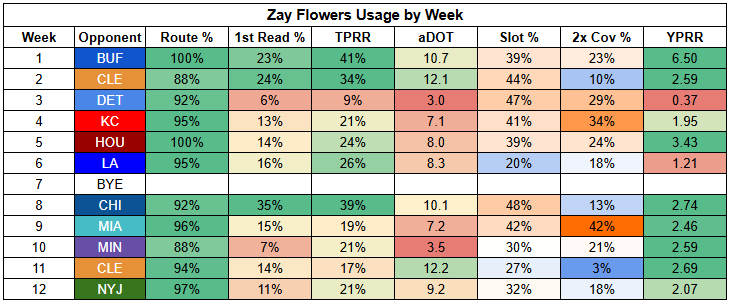
Since Jackson has returned, Flowers isn't dominating targets; he's just producing very efficiently on the looks he's getting. However, to start the year, Flowers' connection with Jackson looked completely locked in. He now gets a Bengals defense with a strong reputation against No. 1 WRs... but not one I think is actually earned.
Cincinnati has played the Browns, Packers, and Jets (without Garrett Wilson). You don't get credit for shutting down the "No. 1 WR" in those matchups. To their credit, they twice limited DK Metcalf (1.43 and 1.48 YPRR), successfully bottled up Brian Thomas (1.17) and Stefon Diggs (0.95), and completely shut down Rome Odunze (0.00). But Amon-Ra St. Brown posted 8/100/0 with 4.00 YPRR against them; Justin Jefferson posted 5/75/0 with 2.88 YPRR; and Courtland Sutton went 5/81/1 with 1.98 YPRR.
Flowers' profile comes with some volatility, but I'm not at all worried about this matchup. If anything, with Burrow potentially pushing the Ravens to the air, this looks like an even better passing setup than the season-long numbers suggest. Flowers is a low-end WR1.
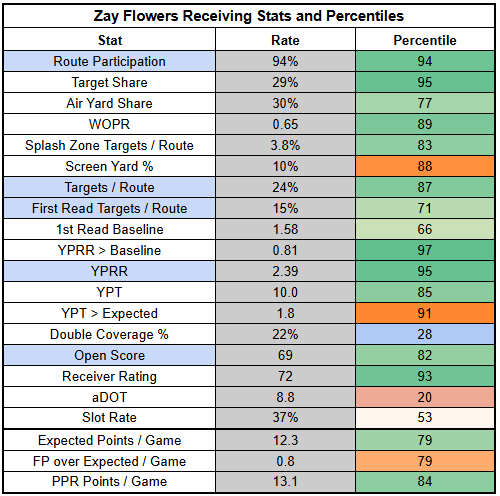
Rashod Bateman is set to return this week, which will likely return DeAndre Hopkins to a rotational role.
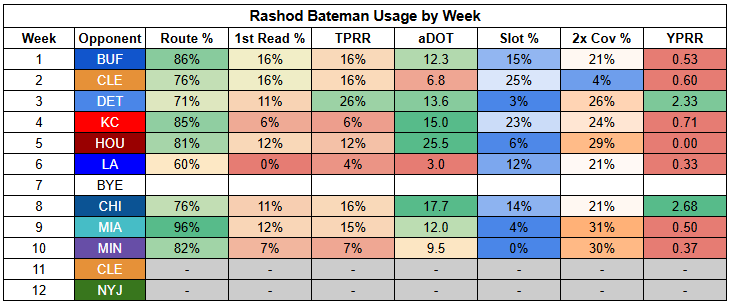
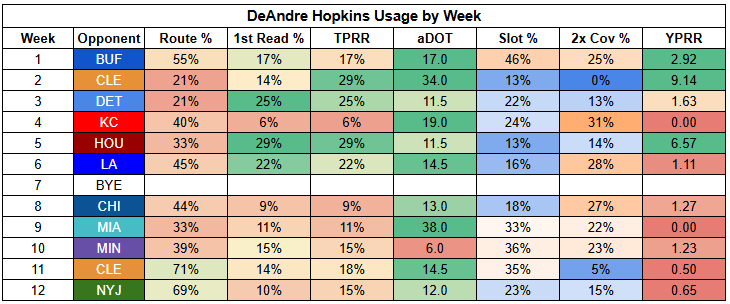
Bateman has not been impressive this year, but while filling in for him, Hopkins wasn't any better. Bateman is a WR5 as a bet on the matchup.
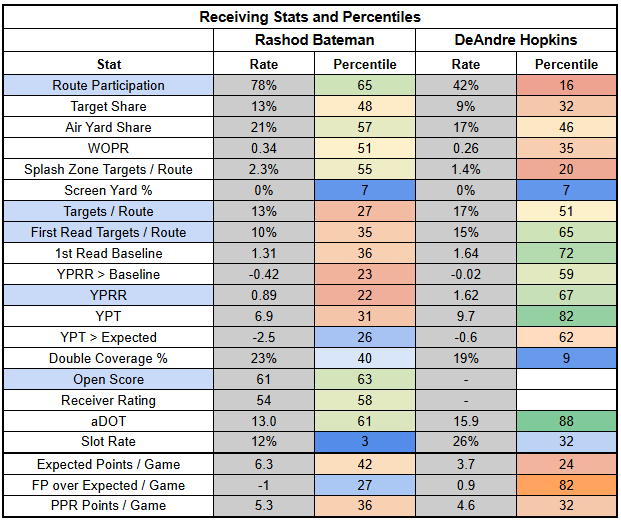
Mark Andrews hasn't scored a TD in a couple of weeks, turning in a 3/32/0 receiving line against the Browns and 1/9/0 against the Jets. He's been TD dependent all year, but we're really feeling it now without those TDs hitting our lineups.
The good news is that Andrews is continuing to play ahead of Isaiah Likely.
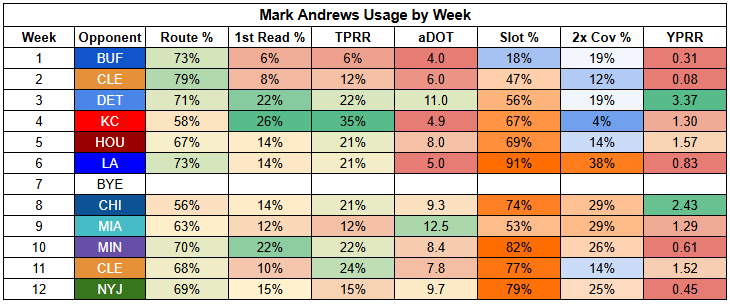

As frustrating as Andrews can be, his profile is still far better than Likely's. Likely is really just a bet on his 2024 profile... which is concerning since we're just over a month out from the calendar flipping to 2026. Still, both players have some matchup-based appeal. Andrews is a low-end TE1, with Likely as a low-end TE2.
